Quality Planning and Analysis for Power Generating Transformer Design and Maintenance
VerifiedAdded on 2023/06/11
|34
|7042
|312
AI Summary
This report covers the planning and analysis of Power Generating Transformer Design and Maintenance by ABC PVT. LTD. It includes customer satisfaction, design requirements, supplier evaluation and selection, statistical process control, problem-solving, and more.
Contribute Materials
Your contribution can guide someone’s learning journey. Share your
documents today.

UTS: ENGINEERING
Assignment Cover Sheet
STANDARD Mode
SUBJECT: Quality Planning and Analysis
SUBJECT NUMBER:
ASSIGNMENT NUMBER:
STUDENT LAST NAME:
STUDENT FIRST NAME:
STUDENT ID:
Assignment Cover Sheet
STANDARD Mode
SUBJECT: Quality Planning and Analysis
SUBJECT NUMBER:
ASSIGNMENT NUMBER:
STUDENT LAST NAME:
STUDENT FIRST NAME:
STUDENT ID:
Secure Best Marks with AI Grader
Need help grading? Try our AI Grader for instant feedback on your assignments.
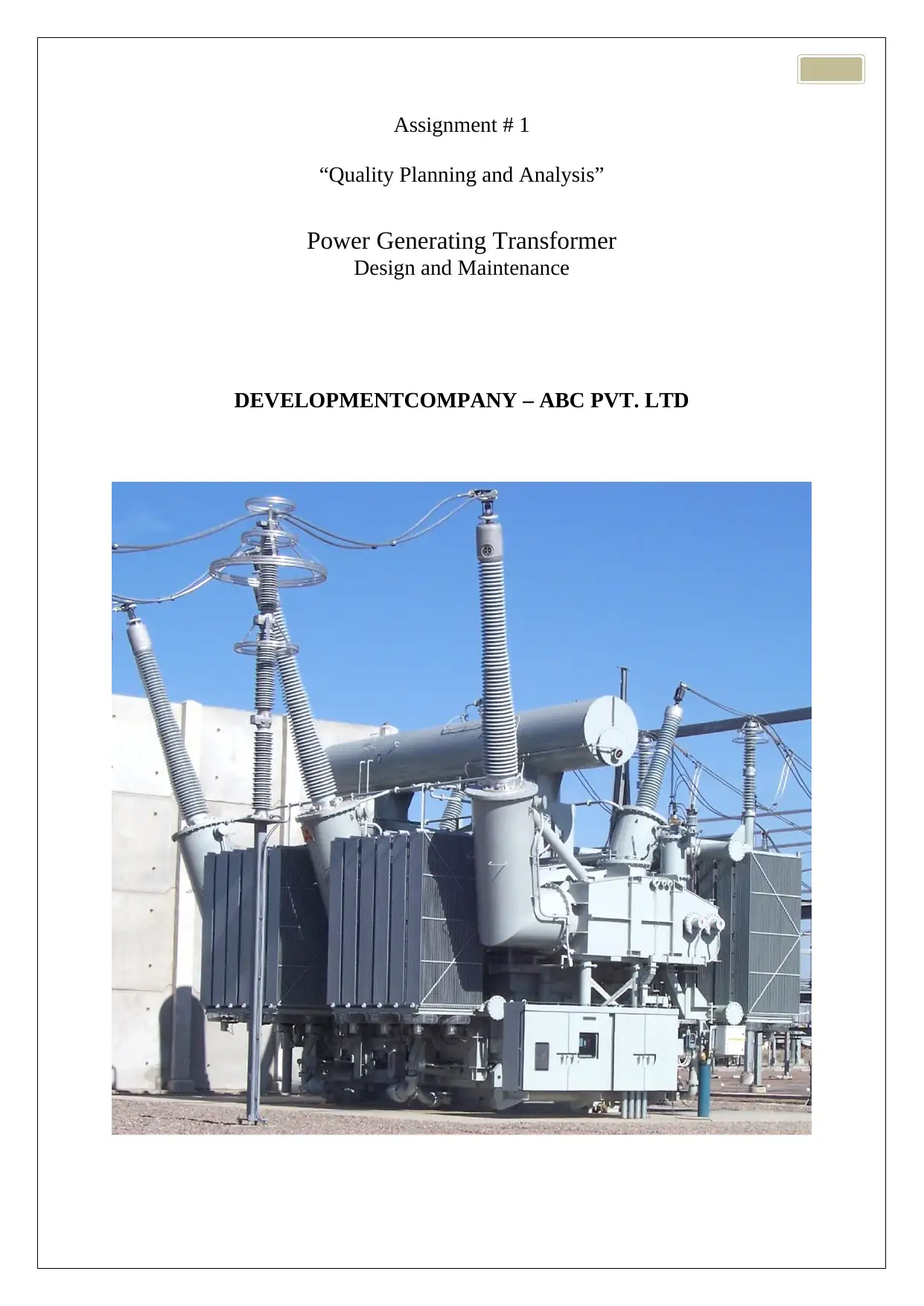
Assignment # 1
“Quality Planning and Analysis”
Power Generating Transformer
Design and Maintenance
DEVELOPMENTCOMPANY – ABC PVT. LTD
“Quality Planning and Analysis”
Power Generating Transformer
Design and Maintenance
DEVELOPMENTCOMPANY – ABC PVT. LTD
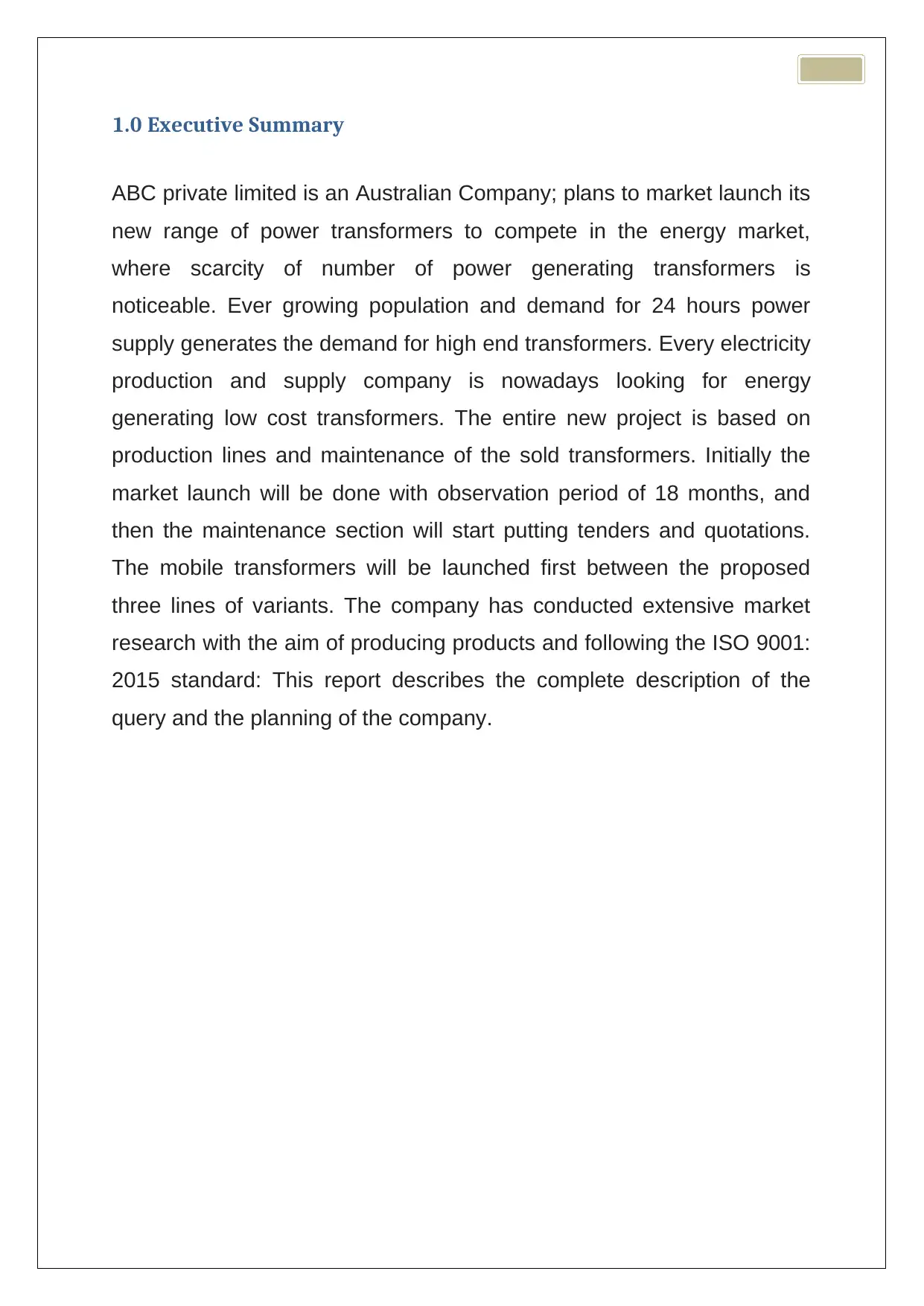
1.0 Executive Summary
ABC private limited is an Australian Company; plans to market launch its
new range of power transformers to compete in the energy market,
where scarcity of number of power generating transformers is
noticeable. Ever growing population and demand for 24 hours power
supply generates the demand for high end transformers. Every electricity
production and supply company is nowadays looking for energy
generating low cost transformers. The entire new project is based on
production lines and maintenance of the sold transformers. Initially the
market launch will be done with observation period of 18 months, and
then the maintenance section will start putting tenders and quotations.
The mobile transformers will be launched first between the proposed
three lines of variants. The company has conducted extensive market
research with the aim of producing products and following the ISO 9001:
2015 standard: This report describes the complete description of the
query and the planning of the company.
ABC private limited is an Australian Company; plans to market launch its
new range of power transformers to compete in the energy market,
where scarcity of number of power generating transformers is
noticeable. Ever growing population and demand for 24 hours power
supply generates the demand for high end transformers. Every electricity
production and supply company is nowadays looking for energy
generating low cost transformers. The entire new project is based on
production lines and maintenance of the sold transformers. Initially the
market launch will be done with observation period of 18 months, and
then the maintenance section will start putting tenders and quotations.
The mobile transformers will be launched first between the proposed
three lines of variants. The company has conducted extensive market
research with the aim of producing products and following the ISO 9001:
2015 standard: This report describes the complete description of the
query and the planning of the company.
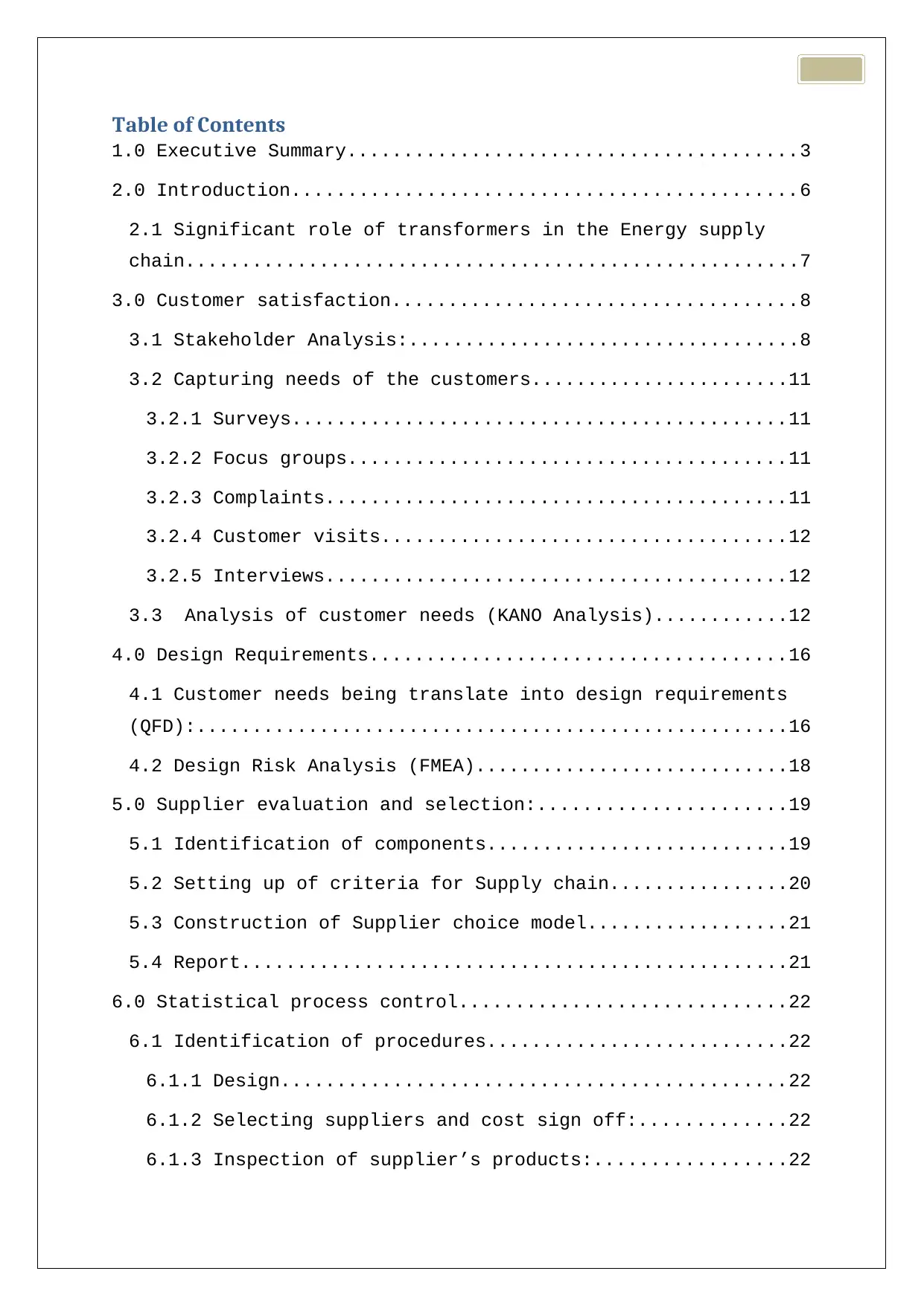
Table of Contents
1.0 Executive Summary........................................3
2.0 Introduction.............................................6
2.1 Significant role of transformers in the Energy supply
chain.......................................................7
3.0 Customer satisfaction....................................8
3.1 Stakeholder Analysis:...................................8
3.2 Capturing needs of the customers.......................11
3.2.1 Surveys............................................11
3.2.2 Focus groups.......................................11
3.2.3 Complaints.........................................11
3.2.4 Customer visits....................................12
3.2.5 Interviews.........................................12
3.3 Analysis of customer needs (KANO Analysis)............12
4.0 Design Requirements.....................................16
4.1 Customer needs being translate into design requirements
(QFD):.....................................................16
4.2 Design Risk Analysis (FMEA)............................18
5.0 Supplier evaluation and selection:......................19
5.1 Identification of components...........................19
5.2 Setting up of criteria for Supply chain................20
5.3 Construction of Supplier choice model..................21
5.4 Report.................................................21
6.0 Statistical process control.............................22
6.1 Identification of procedures...........................22
6.1.1 Design.............................................22
6.1.2 Selecting suppliers and cost sign off:.............22
6.1.3 Inspection of supplier’s products:.................22
1.0 Executive Summary........................................3
2.0 Introduction.............................................6
2.1 Significant role of transformers in the Energy supply
chain.......................................................7
3.0 Customer satisfaction....................................8
3.1 Stakeholder Analysis:...................................8
3.2 Capturing needs of the customers.......................11
3.2.1 Surveys............................................11
3.2.2 Focus groups.......................................11
3.2.3 Complaints.........................................11
3.2.4 Customer visits....................................12
3.2.5 Interviews.........................................12
3.3 Analysis of customer needs (KANO Analysis)............12
4.0 Design Requirements.....................................16
4.1 Customer needs being translate into design requirements
(QFD):.....................................................16
4.2 Design Risk Analysis (FMEA)............................18
5.0 Supplier evaluation and selection:......................19
5.1 Identification of components...........................19
5.2 Setting up of criteria for Supply chain................20
5.3 Construction of Supplier choice model..................21
5.4 Report.................................................21
6.0 Statistical process control.............................22
6.1 Identification of procedures...........................22
6.1.1 Design.............................................22
6.1.2 Selecting suppliers and cost sign off:.............22
6.1.3 Inspection of supplier’s products:.................22
Secure Best Marks with AI Grader
Need help grading? Try our AI Grader for instant feedback on your assignments.

6.1.4 Defect Inspection:.................................23
6.1.5 Testing:...........................................23
6.1.6 Distribution procedures:...........................23
6.1.7 Marketing products:................................23
6.2 Using SPC charts for monitoring:.......................23
6.21 P-chart:............................................24
6.22 NP chart:...........................................24
6.23 C -Chart:...........................................24
6.24 U-chart:............................................24
6.25 X-chart:............................................24
6.3 Construction and usage of SPC chart:...................25
6.4 Explanation............................................26
7.0 Problem solving.........................................27
7.1 Identification of problem solving tools:...............27
7.2 Usage and construction of problem solving tools:.......28
7.2.1 Brainstorming:.....................................28
7.2.2 Causes:............................................28
7.3 Why-Why Analysis.......................................29
7.4 Cause- and –effect diagram.............................29
7.5 Pareto Analysis........................................30
8.0 Conclusion..............................................31
9.0 References..............................................32
6.1.5 Testing:...........................................23
6.1.6 Distribution procedures:...........................23
6.1.7 Marketing products:................................23
6.2 Using SPC charts for monitoring:.......................23
6.21 P-chart:............................................24
6.22 NP chart:...........................................24
6.23 C -Chart:...........................................24
6.24 U-chart:............................................24
6.25 X-chart:............................................24
6.3 Construction and usage of SPC chart:...................25
6.4 Explanation............................................26
7.0 Problem solving.........................................27
7.1 Identification of problem solving tools:...............27
7.2 Usage and construction of problem solving tools:.......28
7.2.1 Brainstorming:.....................................28
7.2.2 Causes:............................................28
7.3 Why-Why Analysis.......................................29
7.4 Cause- and –effect diagram.............................29
7.5 Pareto Analysis........................................30
8.0 Conclusion..............................................31
9.0 References..............................................32
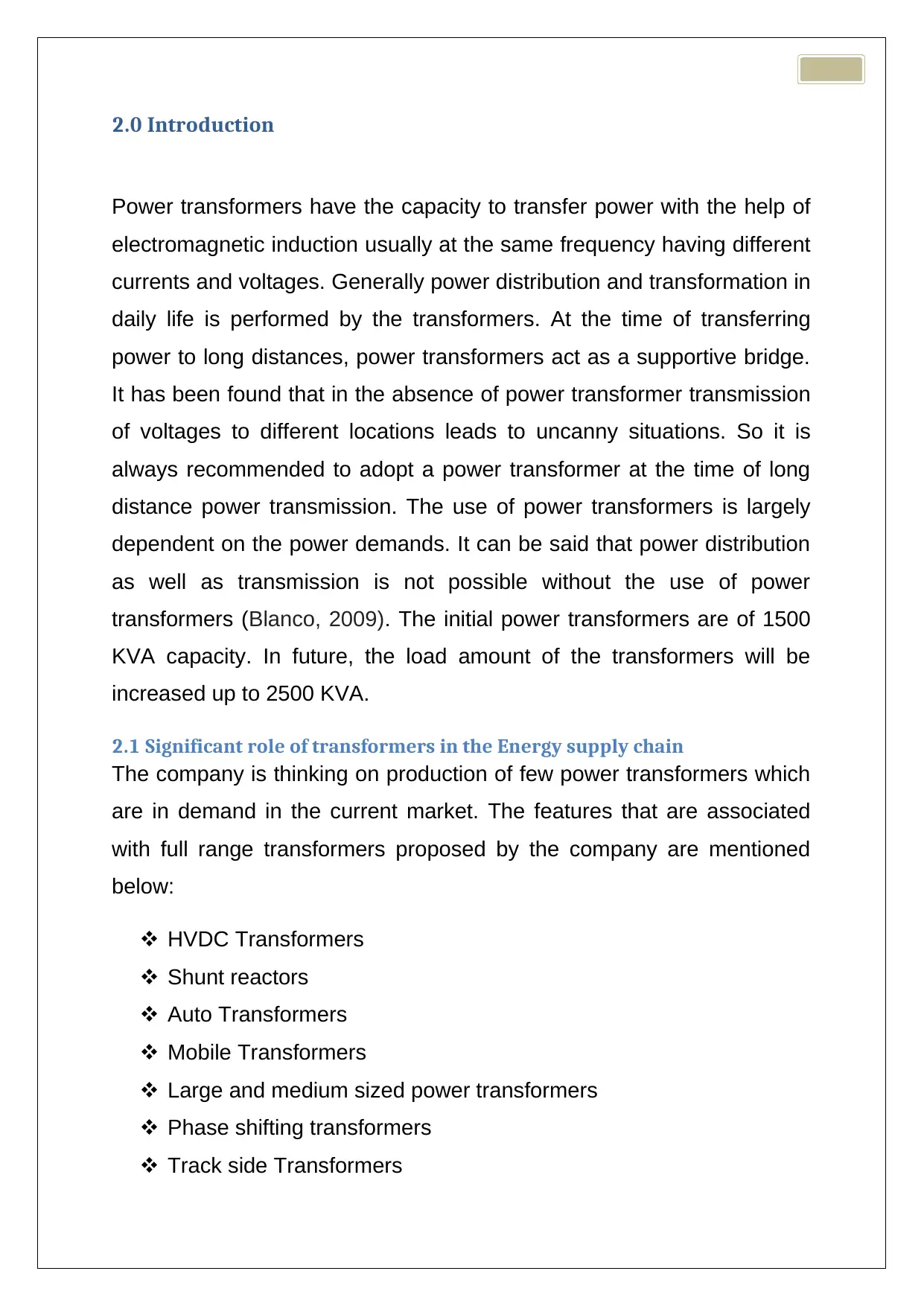
2.0 Introduction
Power transformers have the capacity to transfer power with the help of
electromagnetic induction usually at the same frequency having different
currents and voltages. Generally power distribution and transformation in
daily life is performed by the transformers. At the time of transferring
power to long distances, power transformers act as a supportive bridge.
It has been found that in the absence of power transformer transmission
of voltages to different locations leads to uncanny situations. So it is
always recommended to adopt a power transformer at the time of long
distance power transmission. The use of power transformers is largely
dependent on the power demands. It can be said that power distribution
as well as transmission is not possible without the use of power
transformers (Blanco, 2009). The initial power transformers are of 1500
KVA capacity. In future, the load amount of the transformers will be
increased up to 2500 KVA.
2.1 Significant role of transformers in the Energy supply chain
The company is thinking on production of few power transformers which
are in demand in the current market. The features that are associated
with full range transformers proposed by the company are mentioned
below:
HVDC Transformers
Shunt reactors
Auto Transformers
Mobile Transformers
Large and medium sized power transformers
Phase shifting transformers
Track side Transformers
Power transformers have the capacity to transfer power with the help of
electromagnetic induction usually at the same frequency having different
currents and voltages. Generally power distribution and transformation in
daily life is performed by the transformers. At the time of transferring
power to long distances, power transformers act as a supportive bridge.
It has been found that in the absence of power transformer transmission
of voltages to different locations leads to uncanny situations. So it is
always recommended to adopt a power transformer at the time of long
distance power transmission. The use of power transformers is largely
dependent on the power demands. It can be said that power distribution
as well as transmission is not possible without the use of power
transformers (Blanco, 2009). The initial power transformers are of 1500
KVA capacity. In future, the load amount of the transformers will be
increased up to 2500 KVA.
2.1 Significant role of transformers in the Energy supply chain
The company is thinking on production of few power transformers which
are in demand in the current market. The features that are associated
with full range transformers proposed by the company are mentioned
below:
HVDC Transformers
Shunt reactors
Auto Transformers
Mobile Transformers
Large and medium sized power transformers
Phase shifting transformers
Track side Transformers

Usually two or more coils are wrapped in and around a magnetic
material in a transformer. Transformers react differently in relation to AC
and DC currents. For example: DC current can pass through the
transformer without encountering any change in the wires however AC
current cerates significant impact upon the wires. As the current passes
into one coil then flow to another coil does hamper. Transformers are
able to understand the need of voltage by checking on the turning of the
coils (Borucki, Boczar & Cichoń, 2011). Voltage can be defined as
energy per charged particle and current is defined as the flow of charge
per second. There is a direct correlation between voltage and current
flow. With the increase in the voltage, there is a significant increase in
the flow of current. Alternating flux is known to produce an alternating
current and the flux varies so as to ensure self-induced emf that is found
across winding. This system works in accordance with Faraday’s law of
electromagnetic induction. It can be discerned that supplied voltages act
as cause and emf is its effect. As per Lenz’s affect works in opposition to
cause. Self-induce emf is highly dependent on supplied voltage and not
on the number of turns taken by coil (Borghetti at al., 2009).
3.0 Customer satisfaction
3.1 Stakeholder Analysis:
The stakeholder analysis has been performed in a planed way (Reed et
al., 2009). The Australian company proposes to take note of all the
stakeholders and satisfy their needs and demands in near future. The
stakeholder analysis has been done and represented in tabular format.
All the stakeholders, starting from government to contractual workers,
have been taken into account. In the last financial year the company
material in a transformer. Transformers react differently in relation to AC
and DC currents. For example: DC current can pass through the
transformer without encountering any change in the wires however AC
current cerates significant impact upon the wires. As the current passes
into one coil then flow to another coil does hamper. Transformers are
able to understand the need of voltage by checking on the turning of the
coils (Borucki, Boczar & Cichoń, 2011). Voltage can be defined as
energy per charged particle and current is defined as the flow of charge
per second. There is a direct correlation between voltage and current
flow. With the increase in the voltage, there is a significant increase in
the flow of current. Alternating flux is known to produce an alternating
current and the flux varies so as to ensure self-induced emf that is found
across winding. This system works in accordance with Faraday’s law of
electromagnetic induction. It can be discerned that supplied voltages act
as cause and emf is its effect. As per Lenz’s affect works in opposition to
cause. Self-induce emf is highly dependent on supplied voltage and not
on the number of turns taken by coil (Borghetti at al., 2009).
3.0 Customer satisfaction
3.1 Stakeholder Analysis:
The stakeholder analysis has been performed in a planed way (Reed et
al., 2009). The Australian company proposes to take note of all the
stakeholders and satisfy their needs and demands in near future. The
stakeholder analysis has been done and represented in tabular format.
All the stakeholders, starting from government to contractual workers,
have been taken into account. In the last financial year the company
Paraphrase This Document
Need a fresh take? Get an instant paraphrase of this document with our AI Paraphraser
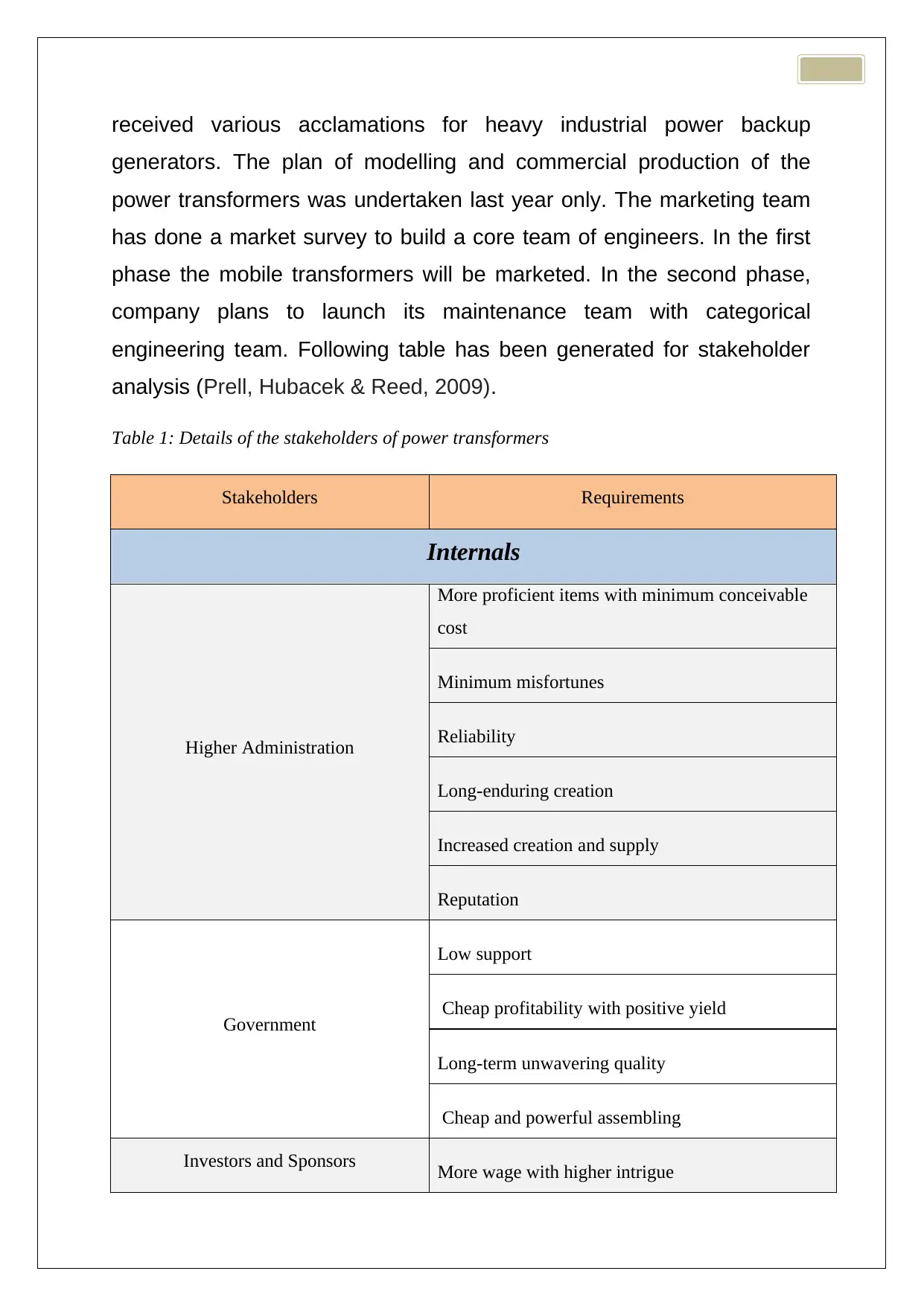
received various acclamations for heavy industrial power backup
generators. The plan of modelling and commercial production of the
power transformers was undertaken last year only. The marketing team
has done a market survey to build a core team of engineers. In the first
phase the mobile transformers will be marketed. In the second phase,
company plans to launch its maintenance team with categorical
engineering team. Following table has been generated for stakeholder
analysis (Prell, Hubacek & Reed, 2009).
Table 1: Details of the stakeholders of power transformers
Stakeholders Requirements
Internals
Higher Administration
More proficient items with minimum conceivable
cost
Minimum misfortunes
Reliability
Long-enduring creation
Increased creation and supply
Reputation
Government
Low support
Cheap profitability with positive yield
Long-term unwavering quality
Cheap and powerful assembling
Investors and Sponsors More wage with higher intrigue
generators. The plan of modelling and commercial production of the
power transformers was undertaken last year only. The marketing team
has done a market survey to build a core team of engineers. In the first
phase the mobile transformers will be marketed. In the second phase,
company plans to launch its maintenance team with categorical
engineering team. Following table has been generated for stakeholder
analysis (Prell, Hubacek & Reed, 2009).
Table 1: Details of the stakeholders of power transformers
Stakeholders Requirements
Internals
Higher Administration
More proficient items with minimum conceivable
cost
Minimum misfortunes
Reliability
Long-enduring creation
Increased creation and supply
Reputation
Government
Low support
Cheap profitability with positive yield
Long-term unwavering quality
Cheap and powerful assembling
Investors and Sponsors More wage with higher intrigue

More cost sparing ways
Higher profits for the speculation
Internal Auditors
Profitability
More requests
Less debasement
Customer fulfillment
Stable market
Externals
Contractual workers
Timely generation
Instant conveyance
Expect greater requests
Cheap cost
Wholesalers
Ability to deal with surges
Efficient working item
Long enduring administrations
Secured from harms
Providers
Flexibility
Guarantee
Providing upkeep
Higher profits for the speculation
Internal Auditors
Profitability
More requests
Less debasement
Customer fulfillment
Stable market
Externals
Contractual workers
Timely generation
Instant conveyance
Expect greater requests
Cheap cost
Wholesalers
Ability to deal with surges
Efficient working item
Long enduring administrations
Secured from harms
Providers
Flexibility
Guarantee
Providing upkeep
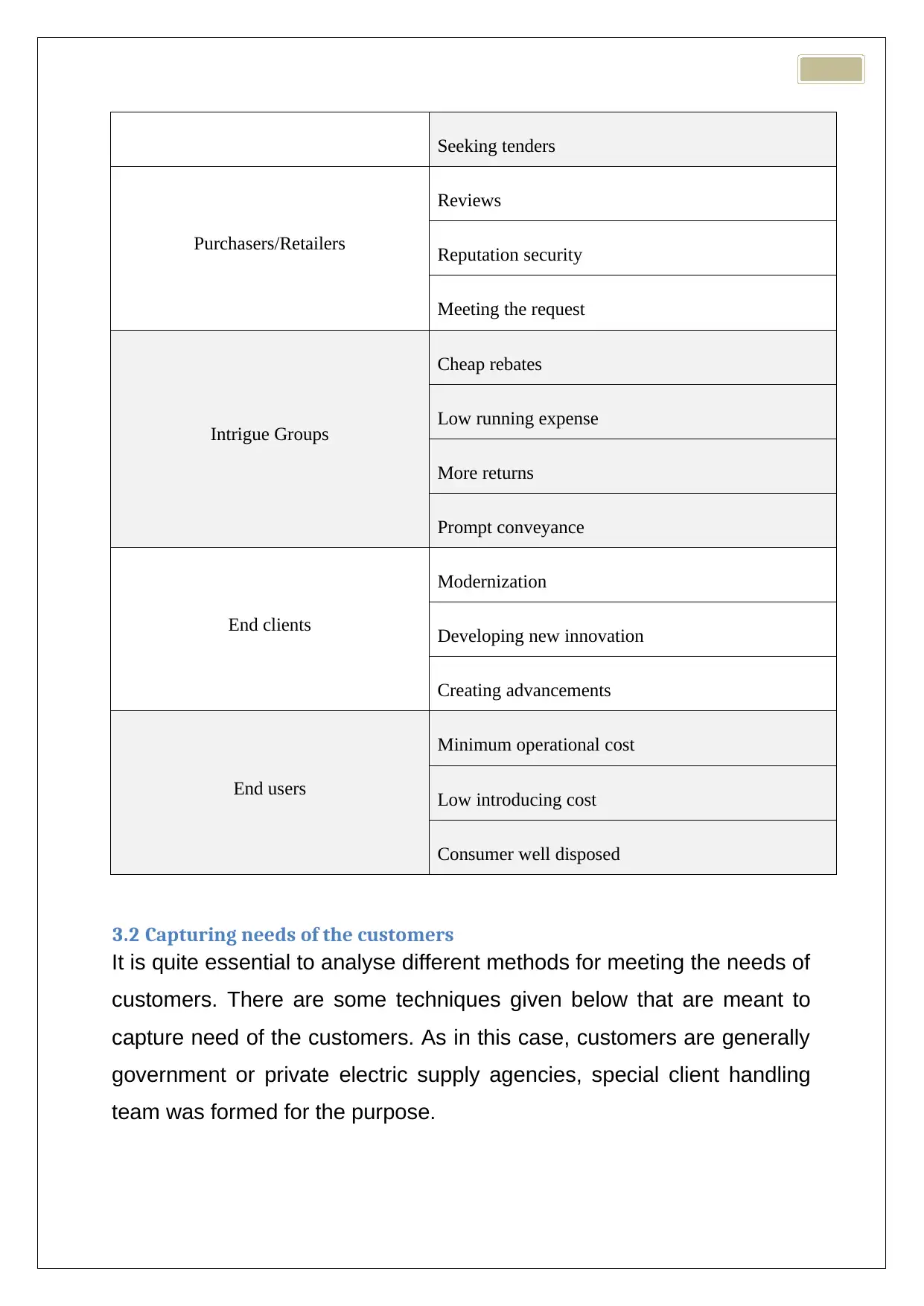
Seeking tenders
Purchasers/Retailers
Reviews
Reputation security
Meeting the request
Intrigue Groups
Cheap rebates
Low running expense
More returns
Prompt conveyance
End clients
Modernization
Developing new innovation
Creating advancements
End users
Minimum operational cost
Low introducing cost
Consumer well disposed
3.2 Capturing needs of the customers
It is quite essential to analyse different methods for meeting the needs of
customers. There are some techniques given below that are meant to
capture need of the customers. As in this case, customers are generally
government or private electric supply agencies, special client handling
team was formed for the purpose.
Purchasers/Retailers
Reviews
Reputation security
Meeting the request
Intrigue Groups
Cheap rebates
Low running expense
More returns
Prompt conveyance
End clients
Modernization
Developing new innovation
Creating advancements
End users
Minimum operational cost
Low introducing cost
Consumer well disposed
3.2 Capturing needs of the customers
It is quite essential to analyse different methods for meeting the needs of
customers. There are some techniques given below that are meant to
capture need of the customers. As in this case, customers are generally
government or private electric supply agencies, special client handling
team was formed for the purpose.
Secure Best Marks with AI Grader
Need help grading? Try our AI Grader for instant feedback on your assignments.
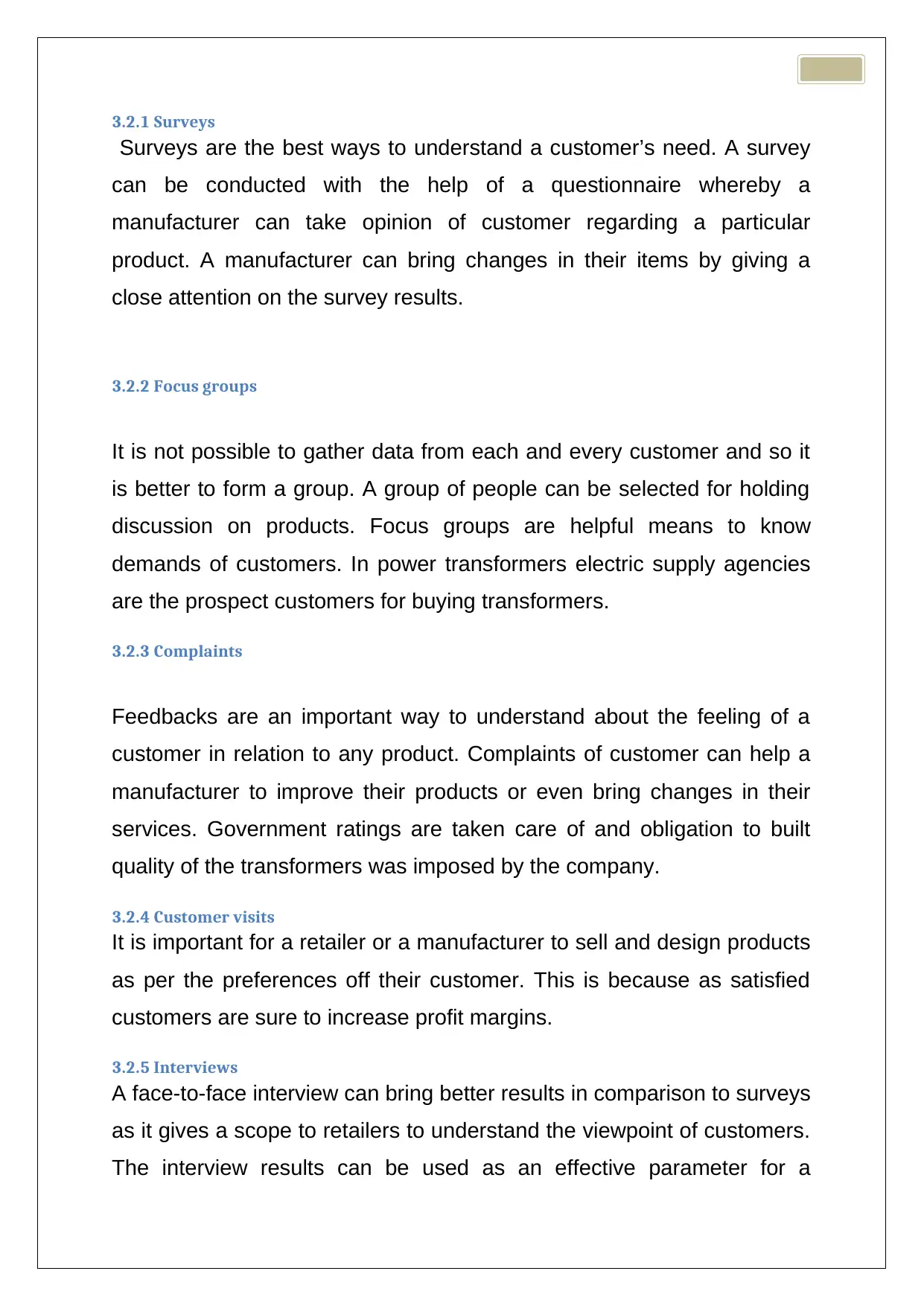
3.2.1 Surveys
Surveys are the best ways to understand a customer’s need. A survey
can be conducted with the help of a questionnaire whereby a
manufacturer can take opinion of customer regarding a particular
product. A manufacturer can bring changes in their items by giving a
close attention on the survey results.
3.2.2 Focus groups
It is not possible to gather data from each and every customer and so it
is better to form a group. A group of people can be selected for holding
discussion on products. Focus groups are helpful means to know
demands of customers. In power transformers electric supply agencies
are the prospect customers for buying transformers.
3.2.3 Complaints
Feedbacks are an important way to understand about the feeling of a
customer in relation to any product. Complaints of customer can help a
manufacturer to improve their products or even bring changes in their
services. Government ratings are taken care of and obligation to built
quality of the transformers was imposed by the company.
3.2.4 Customer visits
It is important for a retailer or a manufacturer to sell and design products
as per the preferences off their customer. This is because as satisfied
customers are sure to increase profit margins.
3.2.5 Interviews
A face-to-face interview can bring better results in comparison to surveys
as it gives a scope to retailers to understand the viewpoint of customers.
The interview results can be used as an effective parameter for a
Surveys are the best ways to understand a customer’s need. A survey
can be conducted with the help of a questionnaire whereby a
manufacturer can take opinion of customer regarding a particular
product. A manufacturer can bring changes in their items by giving a
close attention on the survey results.
3.2.2 Focus groups
It is not possible to gather data from each and every customer and so it
is better to form a group. A group of people can be selected for holding
discussion on products. Focus groups are helpful means to know
demands of customers. In power transformers electric supply agencies
are the prospect customers for buying transformers.
3.2.3 Complaints
Feedbacks are an important way to understand about the feeling of a
customer in relation to any product. Complaints of customer can help a
manufacturer to improve their products or even bring changes in their
services. Government ratings are taken care of and obligation to built
quality of the transformers was imposed by the company.
3.2.4 Customer visits
It is important for a retailer or a manufacturer to sell and design products
as per the preferences off their customer. This is because as satisfied
customers are sure to increase profit margins.
3.2.5 Interviews
A face-to-face interview can bring better results in comparison to surveys
as it gives a scope to retailers to understand the viewpoint of customers.
The interview results can be used as an effective parameter for a
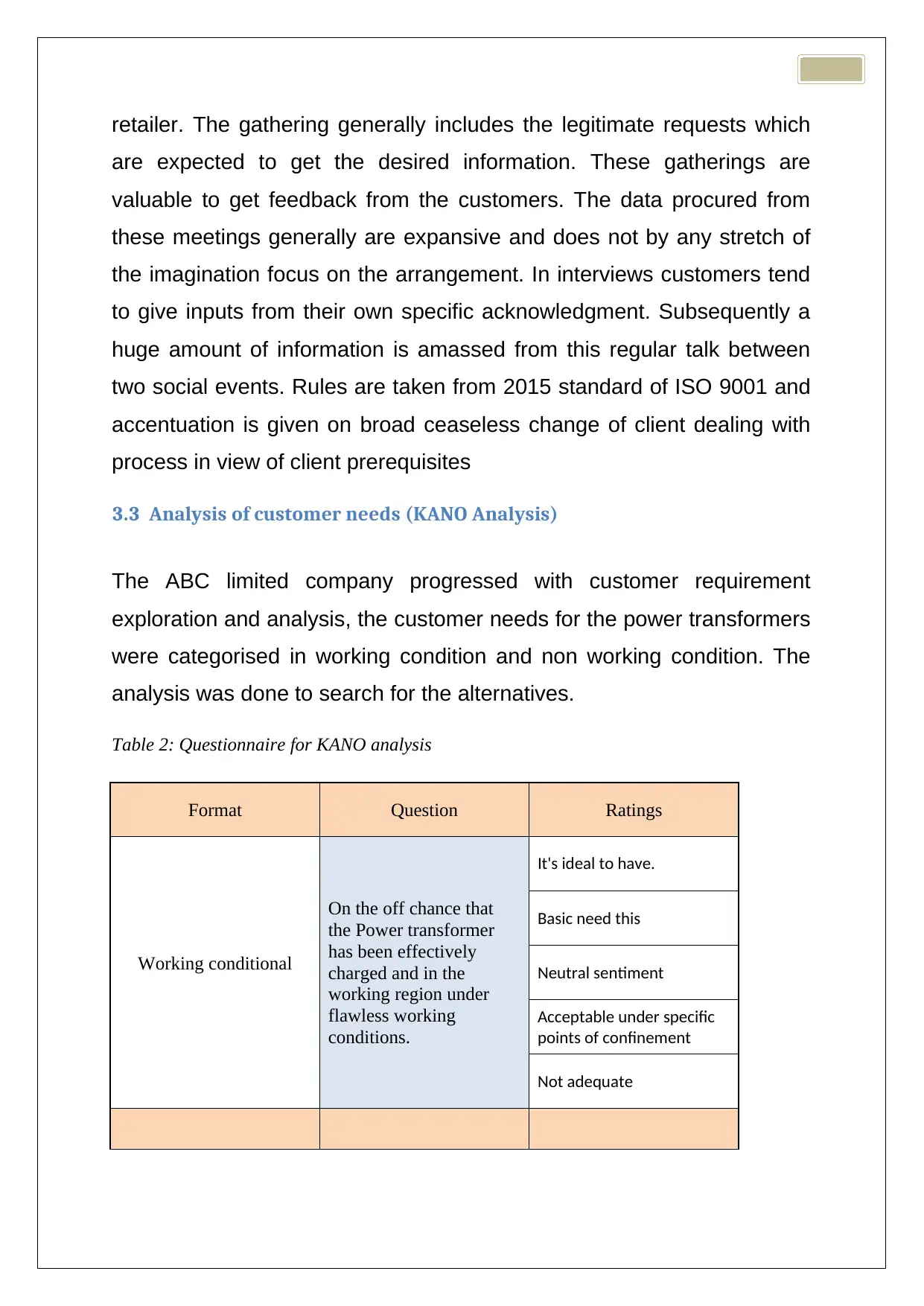
retailer. The gathering generally includes the legitimate requests which
are expected to get the desired information. These gatherings are
valuable to get feedback from the customers. The data procured from
these meetings generally are expansive and does not by any stretch of
the imagination focus on the arrangement. In interviews customers tend
to give inputs from their own specific acknowledgment. Subsequently a
huge amount of information is amassed from this regular talk between
two social events. Rules are taken from 2015 standard of ISO 9001 and
accentuation is given on broad ceaseless change of client dealing with
process in view of client prerequisites
3.3 Analysis of customer needs (KANO Analysis)
The ABC limited company progressed with customer requirement
exploration and analysis, the customer needs for the power transformers
were categorised in working condition and non working condition. The
analysis was done to search for the alternatives.
Table 2: Questionnaire for KANO analysis
Format Question Ratings
Working conditional
On the off chance that
the Power transformer
has been effectively
charged and in the
working region under
flawless working
conditions.
It's ideal to have.
Basic need this
Neutral sentiment
Acceptable under specific
points of confinement
Not adequate
are expected to get the desired information. These gatherings are
valuable to get feedback from the customers. The data procured from
these meetings generally are expansive and does not by any stretch of
the imagination focus on the arrangement. In interviews customers tend
to give inputs from their own specific acknowledgment. Subsequently a
huge amount of information is amassed from this regular talk between
two social events. Rules are taken from 2015 standard of ISO 9001 and
accentuation is given on broad ceaseless change of client dealing with
process in view of client prerequisites
3.3 Analysis of customer needs (KANO Analysis)
The ABC limited company progressed with customer requirement
exploration and analysis, the customer needs for the power transformers
were categorised in working condition and non working condition. The
analysis was done to search for the alternatives.
Table 2: Questionnaire for KANO analysis
Format Question Ratings
Working conditional
On the off chance that
the Power transformer
has been effectively
charged and in the
working region under
flawless working
conditions.
It's ideal to have.
Basic need this
Neutral sentiment
Acceptable under specific
points of confinement
Not adequate
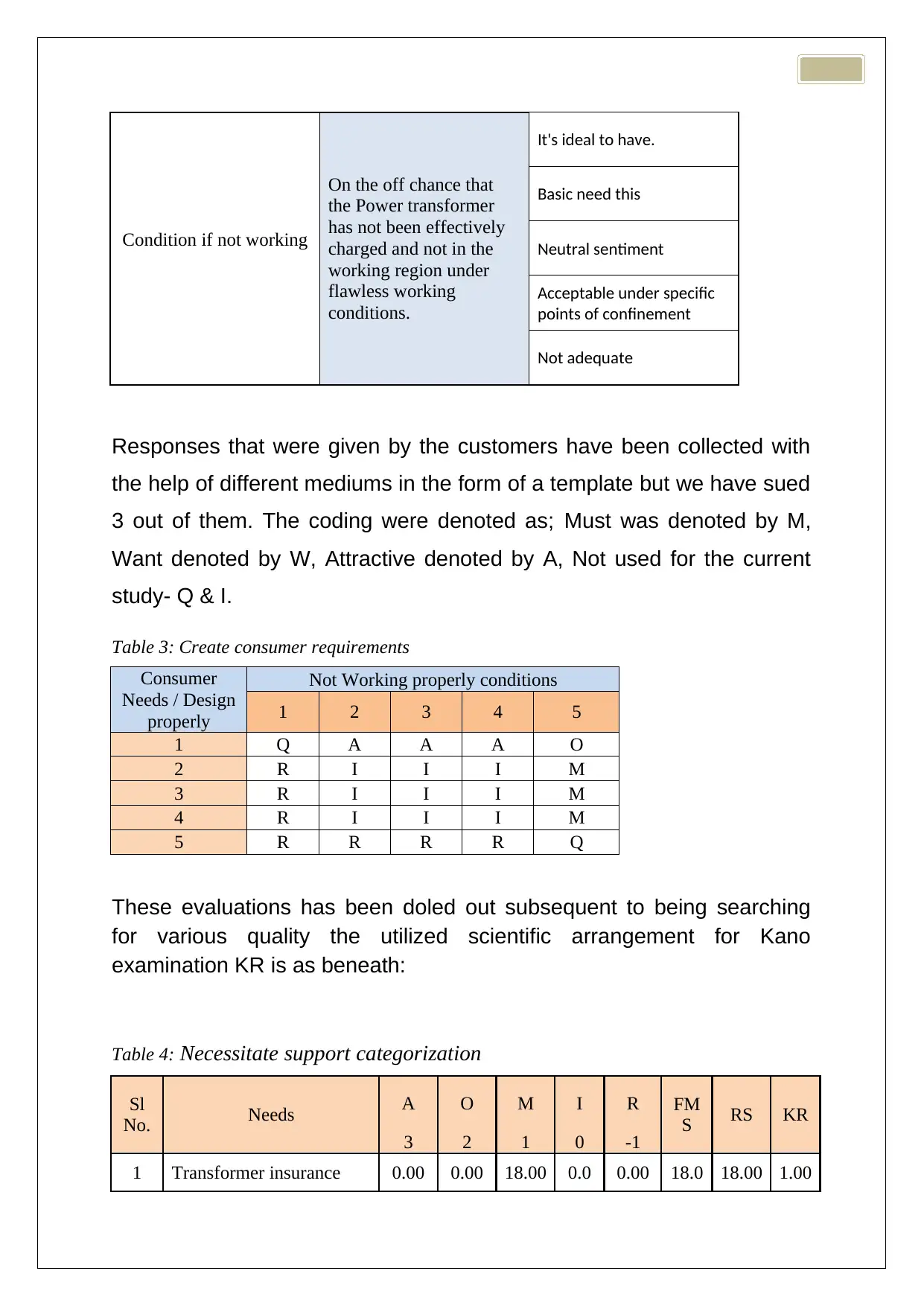
Condition if not working
On the off chance that
the Power transformer
has not been effectively
charged and not in the
working region under
flawless working
conditions.
It's ideal to have.
Basic need this
Neutral sentiment
Acceptable under specific
points of confinement
Not adequate
Responses that were given by the customers have been collected with
the help of different mediums in the form of a template but we have sued
3 out of them. The coding were denoted as; Must was denoted by M,
Want denoted by W, Attractive denoted by A, Not used for the current
study- Q & I.
Table 3: Create consumer requirements
Consumer
Needs / Design
properly
Not Working properly conditions
1 2 3 4 5
1 Q A A A O
2 R I I I M
3 R I I I M
4 R I I I M
5 R R R R Q
These evaluations has been doled out subsequent to being searching
for various quality the utilized scientific arrangement for Kano
examination KR is as beneath:
Table 4: Necessitate support categorization
Sl
No. Needs A O M I R FM
S RS KR
3 2 1 0 -1
1 Transformer insurance 0.00 0.00 18.00 0.0 0.00 18.0 18.00 1.00
On the off chance that
the Power transformer
has not been effectively
charged and not in the
working region under
flawless working
conditions.
It's ideal to have.
Basic need this
Neutral sentiment
Acceptable under specific
points of confinement
Not adequate
Responses that were given by the customers have been collected with
the help of different mediums in the form of a template but we have sued
3 out of them. The coding were denoted as; Must was denoted by M,
Want denoted by W, Attractive denoted by A, Not used for the current
study- Q & I.
Table 3: Create consumer requirements
Consumer
Needs / Design
properly
Not Working properly conditions
1 2 3 4 5
1 Q A A A O
2 R I I I M
3 R I I I M
4 R I I I M
5 R R R R Q
These evaluations has been doled out subsequent to being searching
for various quality the utilized scientific arrangement for Kano
examination KR is as beneath:
Table 4: Necessitate support categorization
Sl
No. Needs A O M I R FM
S RS KR
3 2 1 0 -1
1 Transformer insurance 0.00 0.00 18.00 0.0 0.00 18.0 18.00 1.00
Paraphrase This Document
Need a fresh take? Get an instant paraphrase of this document with our AI Paraphraser
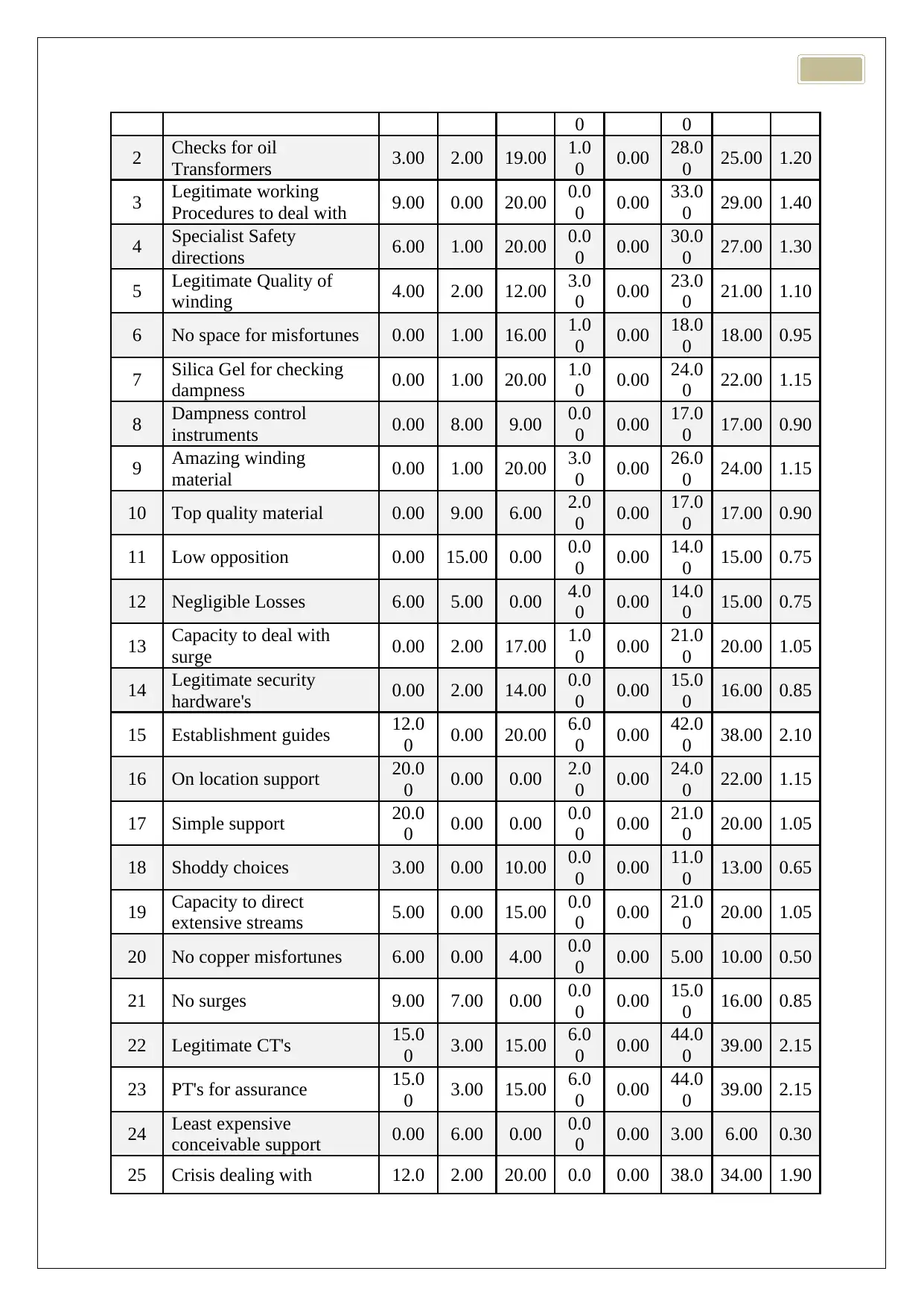
0 0
2 Checks for oil
Transformers 3.00 2.00 19.00 1.0
0 0.00 28.0
0 25.00 1.20
3 Legitimate working
Procedures to deal with 9.00 0.00 20.00 0.0
0 0.00 33.0
0 29.00 1.40
4 Specialist Safety
directions 6.00 1.00 20.00 0.0
0 0.00 30.0
0 27.00 1.30
5 Legitimate Quality of
winding 4.00 2.00 12.00 3.0
0 0.00 23.0
0 21.00 1.10
6 No space for misfortunes 0.00 1.00 16.00 1.0
0 0.00 18.0
0 18.00 0.95
7 Silica Gel for checking
dampness 0.00 1.00 20.00 1.0
0 0.00 24.0
0 22.00 1.15
8 Dampness control
instruments 0.00 8.00 9.00 0.0
0 0.00 17.0
0 17.00 0.90
9 Amazing winding
material 0.00 1.00 20.00 3.0
0 0.00 26.0
0 24.00 1.15
10 Top quality material 0.00 9.00 6.00 2.0
0 0.00 17.0
0 17.00 0.90
11 Low opposition 0.00 15.00 0.00 0.0
0 0.00 14.0
0 15.00 0.75
12 Negligible Losses 6.00 5.00 0.00 4.0
0 0.00 14.0
0 15.00 0.75
13 Capacity to deal with
surge 0.00 2.00 17.00 1.0
0 0.00 21.0
0 20.00 1.05
14 Legitimate security
hardware's 0.00 2.00 14.00 0.0
0 0.00 15.0
0 16.00 0.85
15 Establishment guides 12.0
0 0.00 20.00 6.0
0 0.00 42.0
0 38.00 2.10
16 On location support 20.0
0 0.00 0.00 2.0
0 0.00 24.0
0 22.00 1.15
17 Simple support 20.0
0 0.00 0.00 0.0
0 0.00 21.0
0 20.00 1.05
18 Shoddy choices 3.00 0.00 10.00 0.0
0 0.00 11.0
0 13.00 0.65
19 Capacity to direct
extensive streams 5.00 0.00 15.00 0.0
0 0.00 21.0
0 20.00 1.05
20 No copper misfortunes 6.00 0.00 4.00 0.0
0 0.00 5.00 10.00 0.50
21 No surges 9.00 7.00 0.00 0.0
0 0.00 15.0
0 16.00 0.85
22 Legitimate CT's 15.0
0 3.00 15.00 6.0
0 0.00 44.0
0 39.00 2.15
23 PT's for assurance 15.0
0 3.00 15.00 6.0
0 0.00 44.0
0 39.00 2.15
24 Least expensive
conceivable support 0.00 6.00 0.00 0.0
0 0.00 3.00 6.00 0.30
25 Crisis dealing with 12.0 2.00 20.00 0.0 0.00 38.0 34.00 1.90
2 Checks for oil
Transformers 3.00 2.00 19.00 1.0
0 0.00 28.0
0 25.00 1.20
3 Legitimate working
Procedures to deal with 9.00 0.00 20.00 0.0
0 0.00 33.0
0 29.00 1.40
4 Specialist Safety
directions 6.00 1.00 20.00 0.0
0 0.00 30.0
0 27.00 1.30
5 Legitimate Quality of
winding 4.00 2.00 12.00 3.0
0 0.00 23.0
0 21.00 1.10
6 No space for misfortunes 0.00 1.00 16.00 1.0
0 0.00 18.0
0 18.00 0.95
7 Silica Gel for checking
dampness 0.00 1.00 20.00 1.0
0 0.00 24.0
0 22.00 1.15
8 Dampness control
instruments 0.00 8.00 9.00 0.0
0 0.00 17.0
0 17.00 0.90
9 Amazing winding
material 0.00 1.00 20.00 3.0
0 0.00 26.0
0 24.00 1.15
10 Top quality material 0.00 9.00 6.00 2.0
0 0.00 17.0
0 17.00 0.90
11 Low opposition 0.00 15.00 0.00 0.0
0 0.00 14.0
0 15.00 0.75
12 Negligible Losses 6.00 5.00 0.00 4.0
0 0.00 14.0
0 15.00 0.75
13 Capacity to deal with
surge 0.00 2.00 17.00 1.0
0 0.00 21.0
0 20.00 1.05
14 Legitimate security
hardware's 0.00 2.00 14.00 0.0
0 0.00 15.0
0 16.00 0.85
15 Establishment guides 12.0
0 0.00 20.00 6.0
0 0.00 42.0
0 38.00 2.10
16 On location support 20.0
0 0.00 0.00 2.0
0 0.00 24.0
0 22.00 1.15
17 Simple support 20.0
0 0.00 0.00 0.0
0 0.00 21.0
0 20.00 1.05
18 Shoddy choices 3.00 0.00 10.00 0.0
0 0.00 11.0
0 13.00 0.65
19 Capacity to direct
extensive streams 5.00 0.00 15.00 0.0
0 0.00 21.0
0 20.00 1.05
20 No copper misfortunes 6.00 0.00 4.00 0.0
0 0.00 5.00 10.00 0.50
21 No surges 9.00 7.00 0.00 0.0
0 0.00 15.0
0 16.00 0.85
22 Legitimate CT's 15.0
0 3.00 15.00 6.0
0 0.00 44.0
0 39.00 2.15
23 PT's for assurance 15.0
0 3.00 15.00 6.0
0 0.00 44.0
0 39.00 2.15
24 Least expensive
conceivable support 0.00 6.00 0.00 0.0
0 0.00 3.00 6.00 0.30
25 Crisis dealing with 12.0 2.00 20.00 0.0 0.00 38.0 34.00 1.90
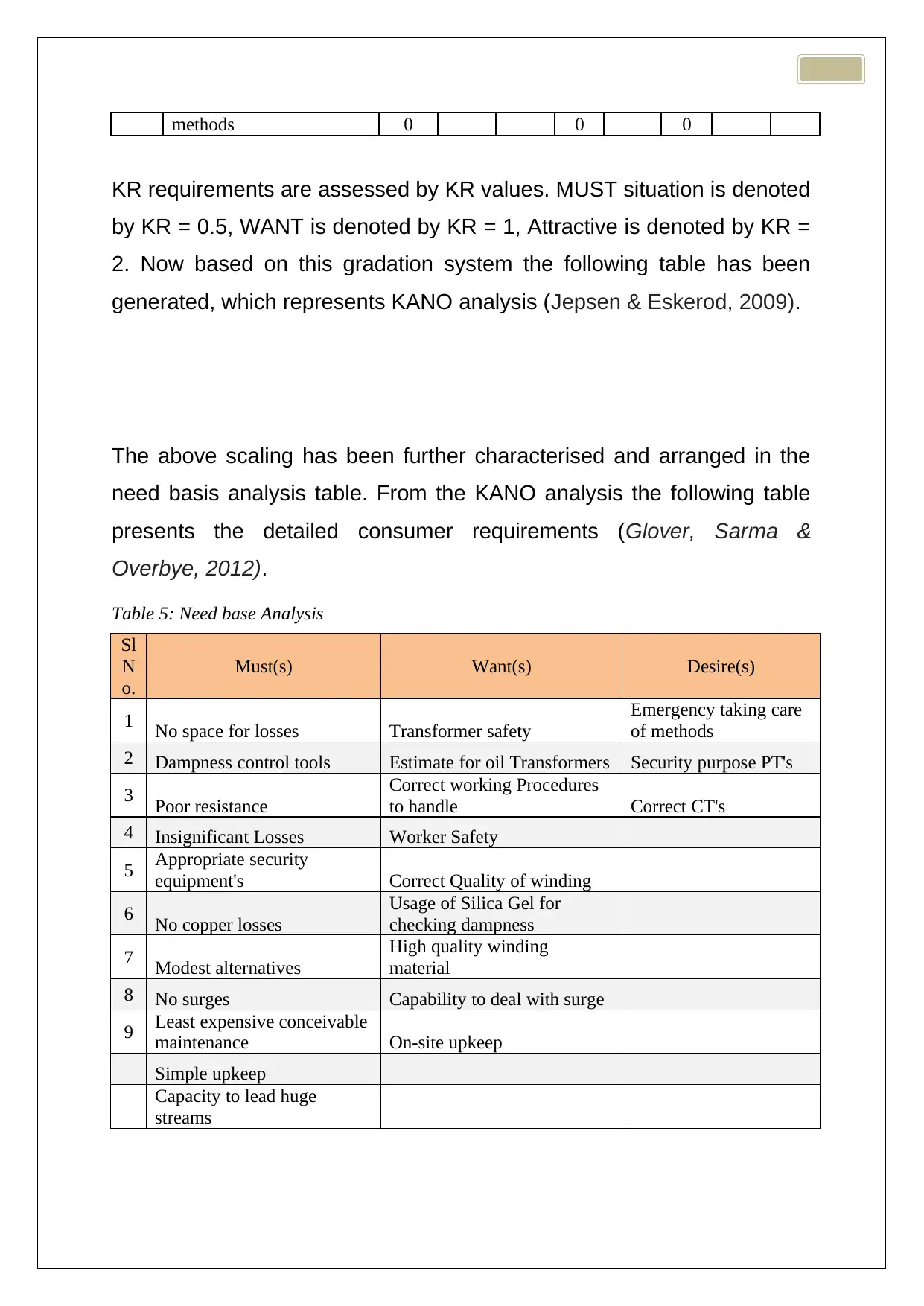
methods 0 0 0
KR requirements are assessed by KR values. MUST situation is denoted
by KR = 0.5, WANT is denoted by KR = 1, Attractive is denoted by KR =
2. Now based on this gradation system the following table has been
generated, which represents KANO analysis (Jepsen & Eskerod, 2009).
The above scaling has been further characterised and arranged in the
need basis analysis table. From the KANO analysis the following table
presents the detailed consumer requirements (Glover, Sarma &
Overbye, 2012).
Table 5: Need base Analysis
Sl
N
o.
Must(s) Want(s) Desire(s)
1 No space for losses Transformer safety
Emergency taking care
of methods
2 Dampness control tools Estimate for oil Transformers Security purpose PT's
3 Poor resistance
Correct working Procedures
to handle Correct CT's
4 Insignificant Losses Worker Safety
5 Appropriate security
equipment's Correct Quality of winding
6 No copper losses
Usage of Silica Gel for
checking dampness
7 Modest alternatives
High quality winding
material
8 No surges Capability to deal with surge
9 Least expensive conceivable
maintenance On-site upkeep
Simple upkeep
Capacity to lead huge
streams
KR requirements are assessed by KR values. MUST situation is denoted
by KR = 0.5, WANT is denoted by KR = 1, Attractive is denoted by KR =
2. Now based on this gradation system the following table has been
generated, which represents KANO analysis (Jepsen & Eskerod, 2009).
The above scaling has been further characterised and arranged in the
need basis analysis table. From the KANO analysis the following table
presents the detailed consumer requirements (Glover, Sarma &
Overbye, 2012).
Table 5: Need base Analysis
Sl
N
o.
Must(s) Want(s) Desire(s)
1 No space for losses Transformer safety
Emergency taking care
of methods
2 Dampness control tools Estimate for oil Transformers Security purpose PT's
3 Poor resistance
Correct working Procedures
to handle Correct CT's
4 Insignificant Losses Worker Safety
5 Appropriate security
equipment's Correct Quality of winding
6 No copper losses
Usage of Silica Gel for
checking dampness
7 Modest alternatives
High quality winding
material
8 No surges Capability to deal with surge
9 Least expensive conceivable
maintenance On-site upkeep
Simple upkeep
Capacity to lead huge
streams
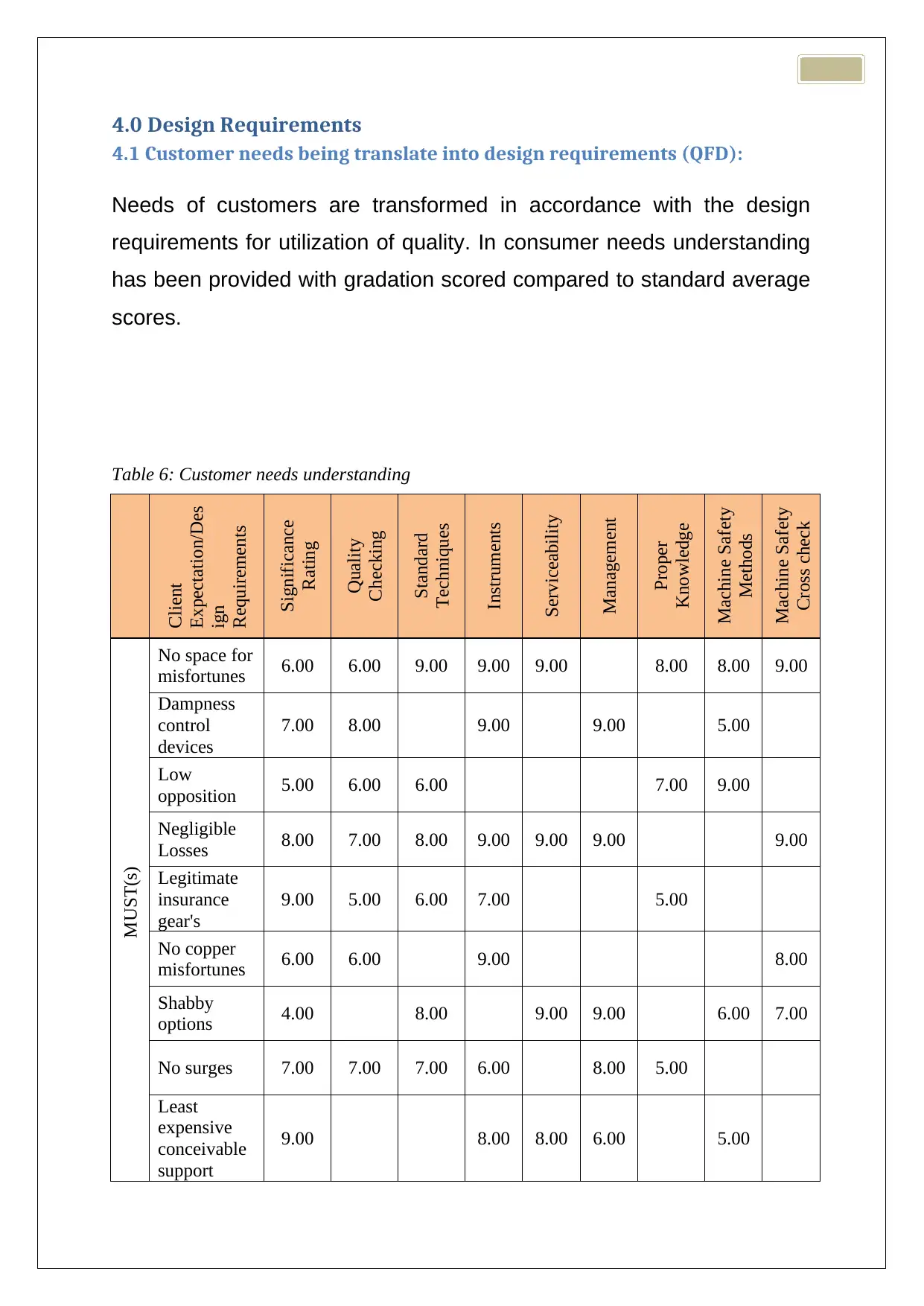
4.0 Design Requirements
4.1 Customer needs being translate into design requirements (QFD):
Needs of customers are transformed in accordance with the design
requirements for utilization of quality. In consumer needs understanding
has been provided with gradation scored compared to standard average
scores.
Table 6: Customer needs understanding
Client
Expectation/Des
ign
Requirements
Significance
Rating
Quality
Checking
Standard
Techniques
Instruments
Serviceability
Management
Proper
Knowledge
Machine Safety
Methods
Machine Safety
Cross check
MUST(s)
No space for
misfortunes 6.00 6.00 9.00 9.00 9.00 8.00 8.00 9.00
Dampness
control
devices
7.00 8.00 9.00 9.00 5.00
Low
opposition 5.00 6.00 6.00 7.00 9.00
Negligible
Losses 8.00 7.00 8.00 9.00 9.00 9.00 9.00
Legitimate
insurance
gear's
9.00 5.00 6.00 7.00 5.00
No copper
misfortunes 6.00 6.00 9.00 8.00
Shabby
options 4.00 8.00 9.00 9.00 6.00 7.00
No surges 7.00 7.00 7.00 6.00 8.00 5.00
Least
expensive
conceivable
support
9.00 8.00 8.00 6.00 5.00
4.1 Customer needs being translate into design requirements (QFD):
Needs of customers are transformed in accordance with the design
requirements for utilization of quality. In consumer needs understanding
has been provided with gradation scored compared to standard average
scores.
Table 6: Customer needs understanding
Client
Expectation/Des
ign
Requirements
Significance
Rating
Quality
Checking
Standard
Techniques
Instruments
Serviceability
Management
Proper
Knowledge
Machine Safety
Methods
Machine Safety
Cross check
MUST(s)
No space for
misfortunes 6.00 6.00 9.00 9.00 9.00 8.00 8.00 9.00
Dampness
control
devices
7.00 8.00 9.00 9.00 5.00
Low
opposition 5.00 6.00 6.00 7.00 9.00
Negligible
Losses 8.00 7.00 8.00 9.00 9.00 9.00 9.00
Legitimate
insurance
gear's
9.00 5.00 6.00 7.00 5.00
No copper
misfortunes 6.00 6.00 9.00 8.00
Shabby
options 4.00 8.00 9.00 9.00 6.00 7.00
No surges 7.00 7.00 7.00 6.00 8.00 5.00
Least
expensive
conceivable
support
9.00 8.00 8.00 6.00 5.00
Secure Best Marks with AI Grader
Need help grading? Try our AI Grader for instant feedback on your assignments.
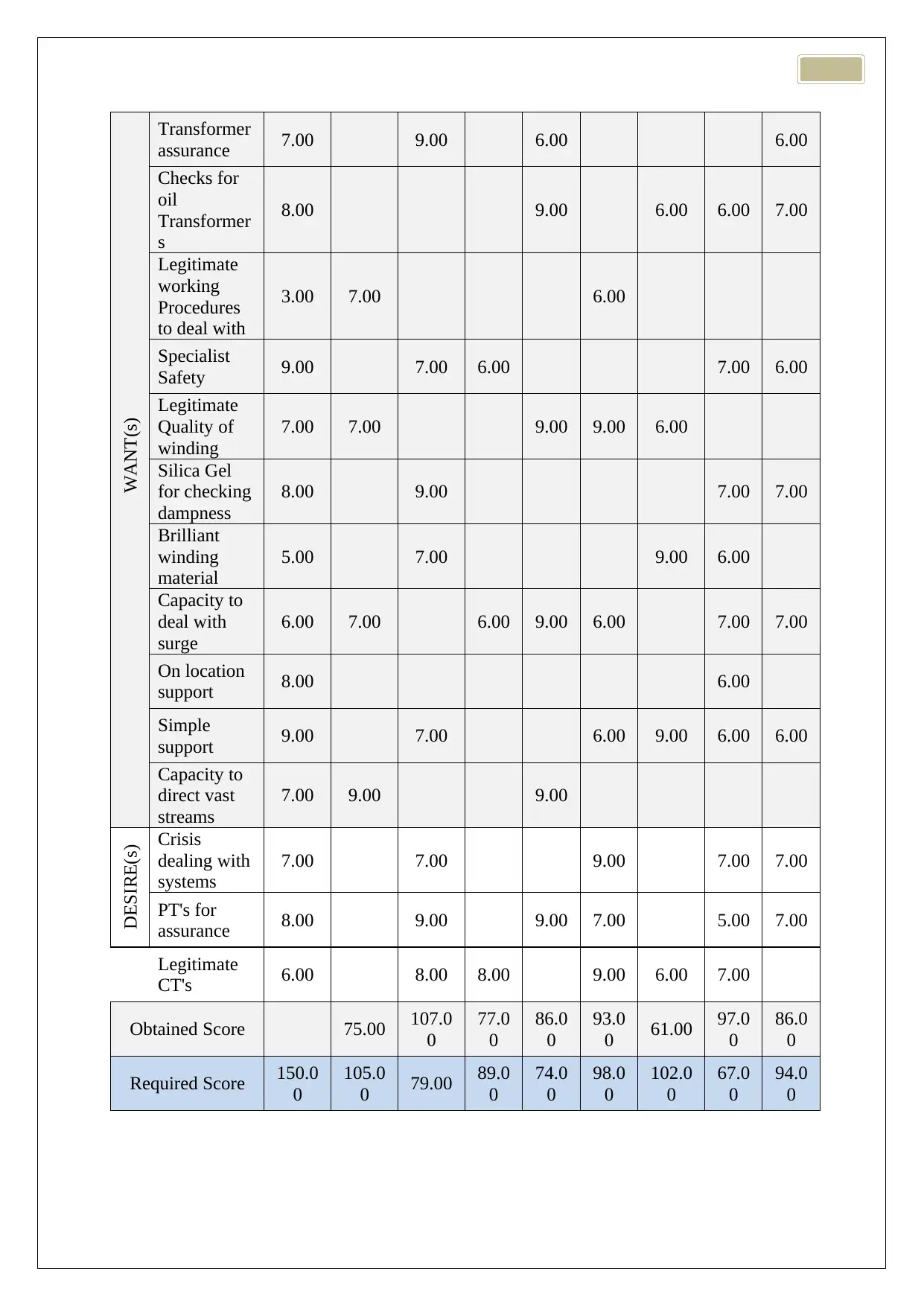
WANT(s)
Transformer
assurance 7.00 9.00 6.00 6.00
Checks for
oil
Transformer
s
8.00 9.00 6.00 6.00 7.00
Legitimate
working
Procedures
to deal with
3.00 7.00 6.00
Specialist
Safety 9.00 7.00 6.00 7.00 6.00
Legitimate
Quality of
winding
7.00 7.00 9.00 9.00 6.00
Silica Gel
for checking
dampness
8.00 9.00 7.00 7.00
Brilliant
winding
material
5.00 7.00 9.00 6.00
Capacity to
deal with
surge
6.00 7.00 6.00 9.00 6.00 7.00 7.00
On location
support 8.00 6.00
Simple
support 9.00 7.00 6.00 9.00 6.00 6.00
Capacity to
direct vast
streams
7.00 9.00 9.00
DESIRE(s) Crisis
dealing with
systems
7.00 7.00 9.00 7.00 7.00
PT's for
assurance 8.00 9.00 9.00 7.00 5.00 7.00
Legitimate
CT's 6.00 8.00 8.00 9.00 6.00 7.00
Obtained Score 75.00 107.0
0
77.0
0
86.0
0
93.0
0 61.00 97.0
0
86.0
0
Required Score 150.0
0
105.0
0 79.00 89.0
0
74.0
0
98.0
0
102.0
0
67.0
0
94.0
0
Transformer
assurance 7.00 9.00 6.00 6.00
Checks for
oil
Transformer
s
8.00 9.00 6.00 6.00 7.00
Legitimate
working
Procedures
to deal with
3.00 7.00 6.00
Specialist
Safety 9.00 7.00 6.00 7.00 6.00
Legitimate
Quality of
winding
7.00 7.00 9.00 9.00 6.00
Silica Gel
for checking
dampness
8.00 9.00 7.00 7.00
Brilliant
winding
material
5.00 7.00 9.00 6.00
Capacity to
deal with
surge
6.00 7.00 6.00 9.00 6.00 7.00 7.00
On location
support 8.00 6.00
Simple
support 9.00 7.00 6.00 9.00 6.00 6.00
Capacity to
direct vast
streams
7.00 9.00 9.00
DESIRE(s) Crisis
dealing with
systems
7.00 7.00 9.00 7.00 7.00
PT's for
assurance 8.00 9.00 9.00 7.00 5.00 7.00
Legitimate
CT's 6.00 8.00 8.00 9.00 6.00 7.00
Obtained Score 75.00 107.0
0
77.0
0
86.0
0
93.0
0 61.00 97.0
0
86.0
0
Required Score 150.0
0
105.0
0 79.00 89.0
0
74.0
0
98.0
0
102.0
0
67.0
0
94.0
0
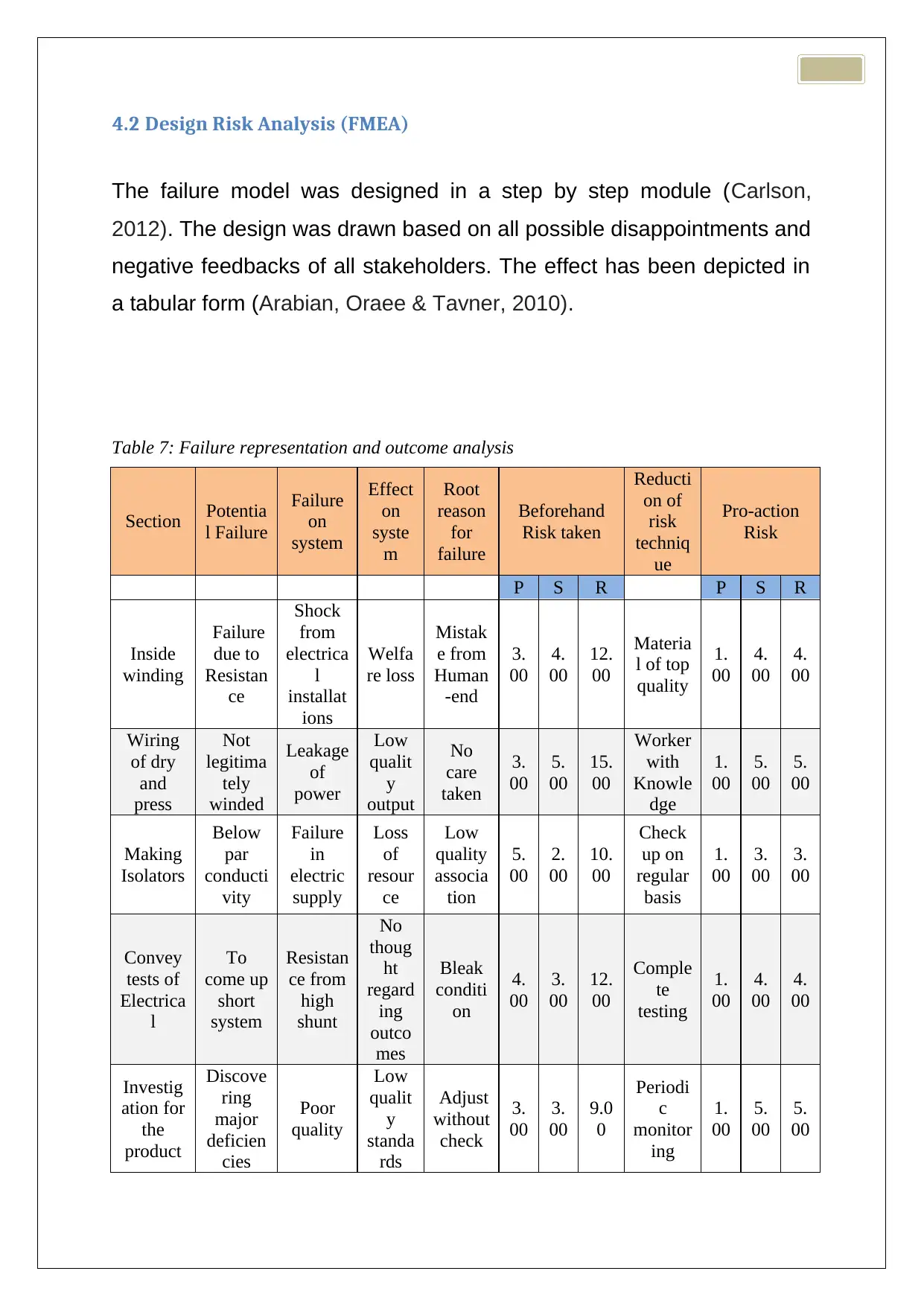
4.2 Design Risk Analysis (FMEA)
The failure model was designed in a step by step module (Carlson,
2012). The design was drawn based on all possible disappointments and
negative feedbacks of all stakeholders. The effect has been depicted in
a tabular form (Arabian, Oraee & Tavner, 2010).
Table 7: Failure representation and outcome analysis
Section Potentia
l Failure
Failure
on
system
Effect
on
syste
m
Root
reason
for
failure
Beforehand
Risk taken
Reducti
on of
risk
techniq
ue
Pro-action
Risk
P S R P S R
Inside
winding
Failure
due to
Resistan
ce
Shock
from
electrica
l
installat
ions
Welfa
re loss
Mistak
e from
Human
-end
3.
00
4.
00
12.
00
Materia
l of top
quality
1.
00
4.
00
4.
00
Wiring
of dry
and
press
Not
legitima
tely
winded
Leakage
of
power
Low
qualit
y
output
No
care
taken
3.
00
5.
00
15.
00
Worker
with
Knowle
dge
1.
00
5.
00
5.
00
Making
Isolators
Below
par
conducti
vity
Failure
in
electric
supply
Loss
of
resour
ce
Low
quality
associa
tion
5.
00
2.
00
10.
00
Check
up on
regular
basis
1.
00
3.
00
3.
00
Convey
tests of
Electrica
l
To
come up
short
system
Resistan
ce from
high
shunt
No
thoug
ht
regard
ing
outco
mes
Bleak
conditi
on
4.
00
3.
00
12.
00
Comple
te
testing
1.
00
4.
00
4.
00
Investig
ation for
the
product
Discove
ring
major
deficien
cies
Poor
quality
Low
qualit
y
standa
rds
Adjust
without
check
3.
00
3.
00
9.0
0
Periodi
c
monitor
ing
1.
00
5.
00
5.
00
The failure model was designed in a step by step module (Carlson,
2012). The design was drawn based on all possible disappointments and
negative feedbacks of all stakeholders. The effect has been depicted in
a tabular form (Arabian, Oraee & Tavner, 2010).
Table 7: Failure representation and outcome analysis
Section Potentia
l Failure
Failure
on
system
Effect
on
syste
m
Root
reason
for
failure
Beforehand
Risk taken
Reducti
on of
risk
techniq
ue
Pro-action
Risk
P S R P S R
Inside
winding
Failure
due to
Resistan
ce
Shock
from
electrica
l
installat
ions
Welfa
re loss
Mistak
e from
Human
-end
3.
00
4.
00
12.
00
Materia
l of top
quality
1.
00
4.
00
4.
00
Wiring
of dry
and
press
Not
legitima
tely
winded
Leakage
of
power
Low
qualit
y
output
No
care
taken
3.
00
5.
00
15.
00
Worker
with
Knowle
dge
1.
00
5.
00
5.
00
Making
Isolators
Below
par
conducti
vity
Failure
in
electric
supply
Loss
of
resour
ce
Low
quality
associa
tion
5.
00
2.
00
10.
00
Check
up on
regular
basis
1.
00
3.
00
3.
00
Convey
tests of
Electrica
l
To
come up
short
system
Resistan
ce from
high
shunt
No
thoug
ht
regard
ing
outco
mes
Bleak
conditi
on
4.
00
3.
00
12.
00
Comple
te
testing
1.
00
4.
00
4.
00
Investig
ation for
the
product
Discove
ring
major
deficien
cies
Poor
quality
Low
qualit
y
standa
rds
Adjust
without
check
3.
00
3.
00
9.0
0
Periodi
c
monitor
ing
1.
00
5.
00
5.
00

5.0 Supplier evaluation and selection:
5.1 Identification of components
Power transformers consist of different components and it needs large
number of suppliers. Components that are required to be subcontracted
have been specified below:
Tap charger
Insulating materials
Wires
Human management
Information systems
Windings
Breather
Supply management
Maintenance and general services
Integral quality management
Transformer oil
5.2 Setting up of criteria for Supply chain
In order to develop criteria for supply chain, transformer oil can be
chosen from the components. It can be said that transformer oil is
important for the operating power transformers at the time of high
voltages. Transformer continuously operates which results in increase in
their temperature and it is not good for their functionality. That is why
transformer oils lies within its body for lowering down its temperature
thereby reducing chances of blast. It is to be considered as significant for
5.1 Identification of components
Power transformers consist of different components and it needs large
number of suppliers. Components that are required to be subcontracted
have been specified below:
Tap charger
Insulating materials
Wires
Human management
Information systems
Windings
Breather
Supply management
Maintenance and general services
Integral quality management
Transformer oil
5.2 Setting up of criteria for Supply chain
In order to develop criteria for supply chain, transformer oil can be
chosen from the components. It can be said that transformer oil is
important for the operating power transformers at the time of high
voltages. Transformer continuously operates which results in increase in
their temperature and it is not good for their functionality. That is why
transformer oils lies within its body for lowering down its temperature
thereby reducing chances of blast. It is to be considered as significant for
Paraphrase This Document
Need a fresh take? Get an instant paraphrase of this document with our AI Paraphraser
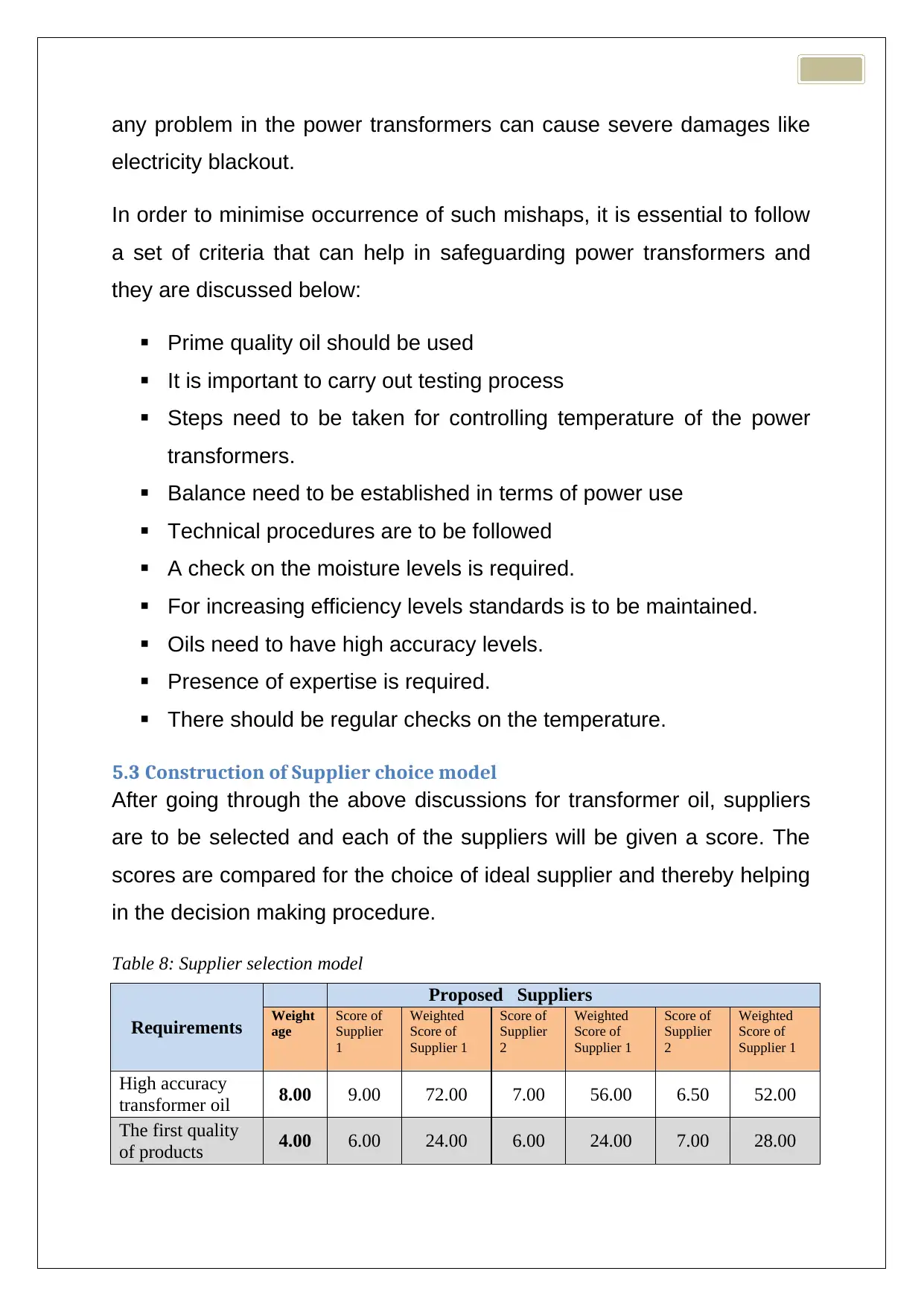
any problem in the power transformers can cause severe damages like
electricity blackout.
In order to minimise occurrence of such mishaps, it is essential to follow
a set of criteria that can help in safeguarding power transformers and
they are discussed below:
Prime quality oil should be used
It is important to carry out testing process
Steps need to be taken for controlling temperature of the power
transformers.
Balance need to be established in terms of power use
Technical procedures are to be followed
A check on the moisture levels is required.
For increasing efficiency levels standards is to be maintained.
Oils need to have high accuracy levels.
Presence of expertise is required.
There should be regular checks on the temperature.
5.3 Construction of Supplier choice model
After going through the above discussions for transformer oil, suppliers
are to be selected and each of the suppliers will be given a score. The
scores are compared for the choice of ideal supplier and thereby helping
in the decision making procedure.
Table 8: Supplier selection model
Requirements
Proposed Suppliers
Weight
age
Score of
Supplier
1
Weighted
Score of
Supplier 1
Score of
Supplier
2
Weighted
Score of
Supplier 1
Score of
Supplier
2
Weighted
Score of
Supplier 1
High accuracy
transformer oil 8.00 9.00 72.00 7.00 56.00 6.50 52.00
The first quality
of products 4.00 6.00 24.00 6.00 24.00 7.00 28.00
electricity blackout.
In order to minimise occurrence of such mishaps, it is essential to follow
a set of criteria that can help in safeguarding power transformers and
they are discussed below:
Prime quality oil should be used
It is important to carry out testing process
Steps need to be taken for controlling temperature of the power
transformers.
Balance need to be established in terms of power use
Technical procedures are to be followed
A check on the moisture levels is required.
For increasing efficiency levels standards is to be maintained.
Oils need to have high accuracy levels.
Presence of expertise is required.
There should be regular checks on the temperature.
5.3 Construction of Supplier choice model
After going through the above discussions for transformer oil, suppliers
are to be selected and each of the suppliers will be given a score. The
scores are compared for the choice of ideal supplier and thereby helping
in the decision making procedure.
Table 8: Supplier selection model
Requirements
Proposed Suppliers
Weight
age
Score of
Supplier
1
Weighted
Score of
Supplier 1
Score of
Supplier
2
Weighted
Score of
Supplier 1
Score of
Supplier
2
Weighted
Score of
Supplier 1
High accuracy
transformer oil 8.00 9.00 72.00 7.00 56.00 6.50 52.00
The first quality
of products 4.00 6.00 24.00 6.00 24.00 7.00 28.00
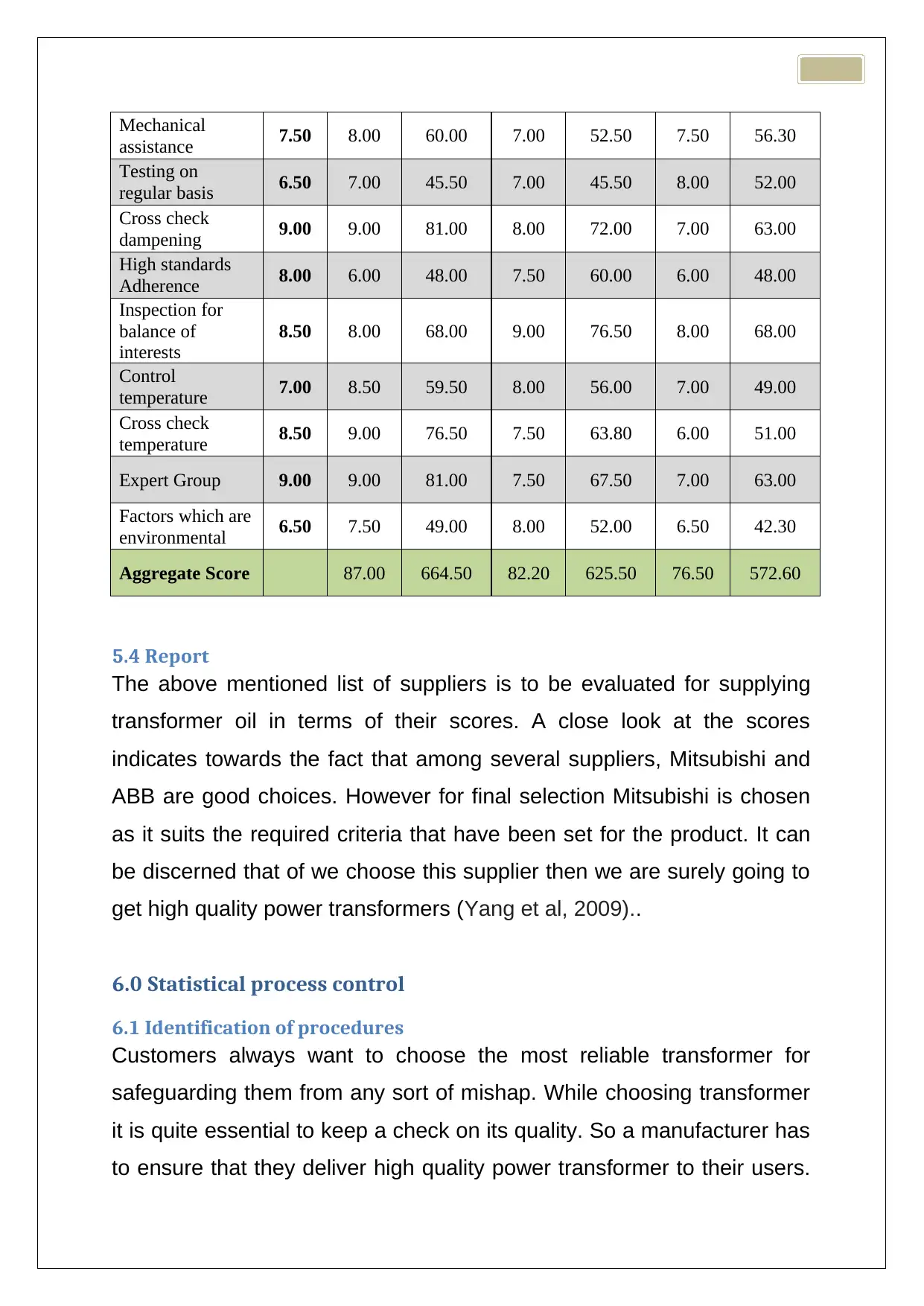
Mechanical
assistance 7.50 8.00 60.00 7.00 52.50 7.50 56.30
Testing on
regular basis 6.50 7.00 45.50 7.00 45.50 8.00 52.00
Cross check
dampening 9.00 9.00 81.00 8.00 72.00 7.00 63.00
High standards
Adherence 8.00 6.00 48.00 7.50 60.00 6.00 48.00
Inspection for
balance of
interests
8.50 8.00 68.00 9.00 76.50 8.00 68.00
Control
temperature 7.00 8.50 59.50 8.00 56.00 7.00 49.00
Cross check
temperature 8.50 9.00 76.50 7.50 63.80 6.00 51.00
Expert Group 9.00 9.00 81.00 7.50 67.50 7.00 63.00
Factors which are
environmental 6.50 7.50 49.00 8.00 52.00 6.50 42.30
Aggregate Score 87.00 664.50 82.20 625.50 76.50 572.60
5.4 Report
The above mentioned list of suppliers is to be evaluated for supplying
transformer oil in terms of their scores. A close look at the scores
indicates towards the fact that among several suppliers, Mitsubishi and
ABB are good choices. However for final selection Mitsubishi is chosen
as it suits the required criteria that have been set for the product. It can
be discerned that of we choose this supplier then we are surely going to
get high quality power transformers (Yang et al, 2009)..
6.0 Statistical process control
6.1 Identification of procedures
Customers always want to choose the most reliable transformer for
safeguarding them from any sort of mishap. While choosing transformer
it is quite essential to keep a check on its quality. So a manufacturer has
to ensure that they deliver high quality power transformer to their users.
assistance 7.50 8.00 60.00 7.00 52.50 7.50 56.30
Testing on
regular basis 6.50 7.00 45.50 7.00 45.50 8.00 52.00
Cross check
dampening 9.00 9.00 81.00 8.00 72.00 7.00 63.00
High standards
Adherence 8.00 6.00 48.00 7.50 60.00 6.00 48.00
Inspection for
balance of
interests
8.50 8.00 68.00 9.00 76.50 8.00 68.00
Control
temperature 7.00 8.50 59.50 8.00 56.00 7.00 49.00
Cross check
temperature 8.50 9.00 76.50 7.50 63.80 6.00 51.00
Expert Group 9.00 9.00 81.00 7.50 67.50 7.00 63.00
Factors which are
environmental 6.50 7.50 49.00 8.00 52.00 6.50 42.30
Aggregate Score 87.00 664.50 82.20 625.50 76.50 572.60
5.4 Report
The above mentioned list of suppliers is to be evaluated for supplying
transformer oil in terms of their scores. A close look at the scores
indicates towards the fact that among several suppliers, Mitsubishi and
ABB are good choices. However for final selection Mitsubishi is chosen
as it suits the required criteria that have been set for the product. It can
be discerned that of we choose this supplier then we are surely going to
get high quality power transformers (Yang et al, 2009)..
6.0 Statistical process control
6.1 Identification of procedures
Customers always want to choose the most reliable transformer for
safeguarding them from any sort of mishap. While choosing transformer
it is quite essential to keep a check on its quality. So a manufacturer has
to ensure that they deliver high quality power transformer to their users.
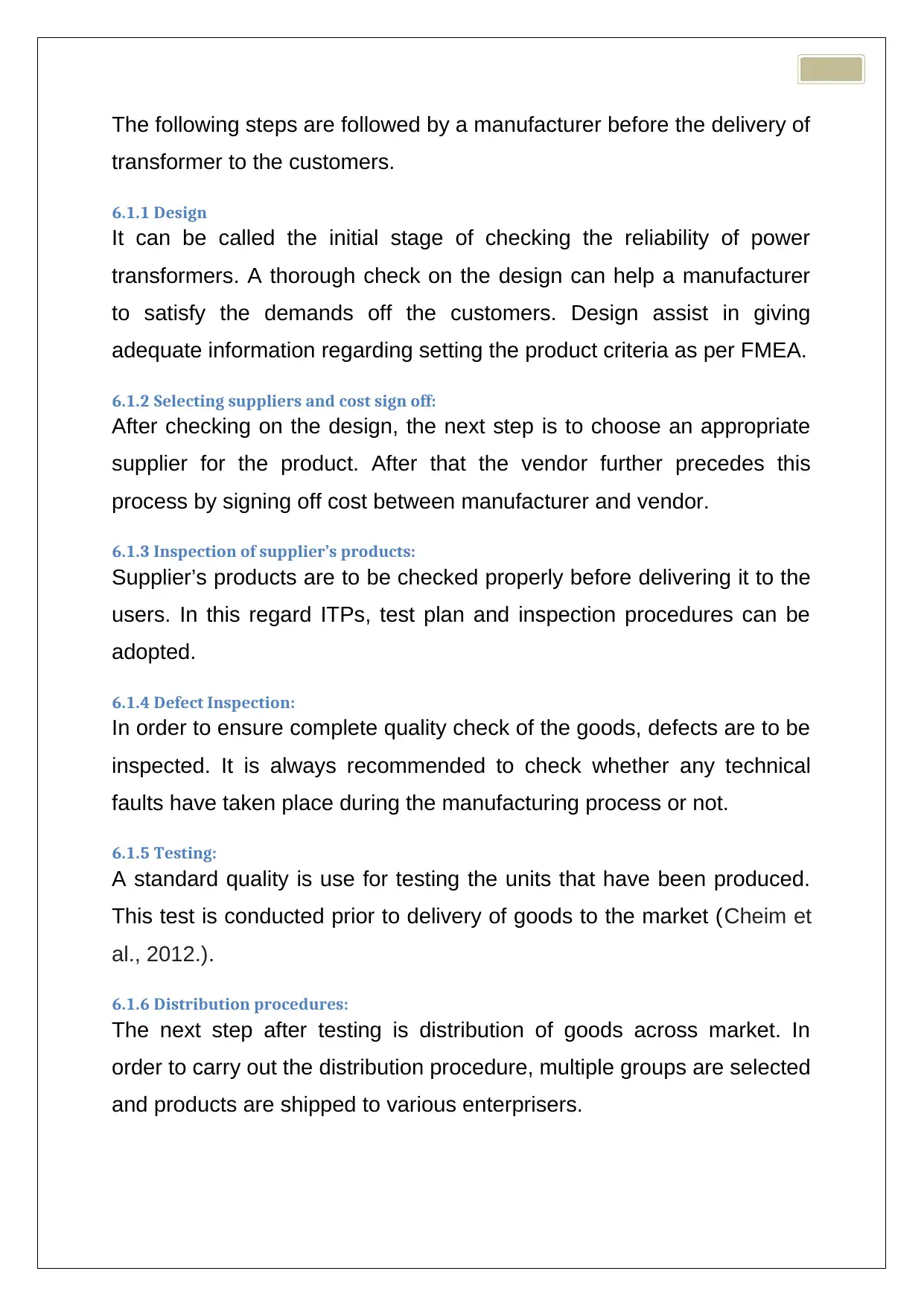
The following steps are followed by a manufacturer before the delivery of
transformer to the customers.
6.1.1 Design
It can be called the initial stage of checking the reliability of power
transformers. A thorough check on the design can help a manufacturer
to satisfy the demands off the customers. Design assist in giving
adequate information regarding setting the product criteria as per FMEA.
6.1.2 Selecting suppliers and cost sign off:
After checking on the design, the next step is to choose an appropriate
supplier for the product. After that the vendor further precedes this
process by signing off cost between manufacturer and vendor.
6.1.3 Inspection of supplier’s products:
Supplier’s products are to be checked properly before delivering it to the
users. In this regard ITPs, test plan and inspection procedures can be
adopted.
6.1.4 Defect Inspection:
In order to ensure complete quality check of the goods, defects are to be
inspected. It is always recommended to check whether any technical
faults have taken place during the manufacturing process or not.
6.1.5 Testing:
A standard quality is use for testing the units that have been produced.
This test is conducted prior to delivery of goods to the market (Cheim et
al., 2012.).
6.1.6 Distribution procedures:
The next step after testing is distribution of goods across market. In
order to carry out the distribution procedure, multiple groups are selected
and products are shipped to various enterprisers.
transformer to the customers.
6.1.1 Design
It can be called the initial stage of checking the reliability of power
transformers. A thorough check on the design can help a manufacturer
to satisfy the demands off the customers. Design assist in giving
adequate information regarding setting the product criteria as per FMEA.
6.1.2 Selecting suppliers and cost sign off:
After checking on the design, the next step is to choose an appropriate
supplier for the product. After that the vendor further precedes this
process by signing off cost between manufacturer and vendor.
6.1.3 Inspection of supplier’s products:
Supplier’s products are to be checked properly before delivering it to the
users. In this regard ITPs, test plan and inspection procedures can be
adopted.
6.1.4 Defect Inspection:
In order to ensure complete quality check of the goods, defects are to be
inspected. It is always recommended to check whether any technical
faults have taken place during the manufacturing process or not.
6.1.5 Testing:
A standard quality is use for testing the units that have been produced.
This test is conducted prior to delivery of goods to the market (Cheim et
al., 2012.).
6.1.6 Distribution procedures:
The next step after testing is distribution of goods across market. In
order to carry out the distribution procedure, multiple groups are selected
and products are shipped to various enterprisers.
Secure Best Marks with AI Grader
Need help grading? Try our AI Grader for instant feedback on your assignments.
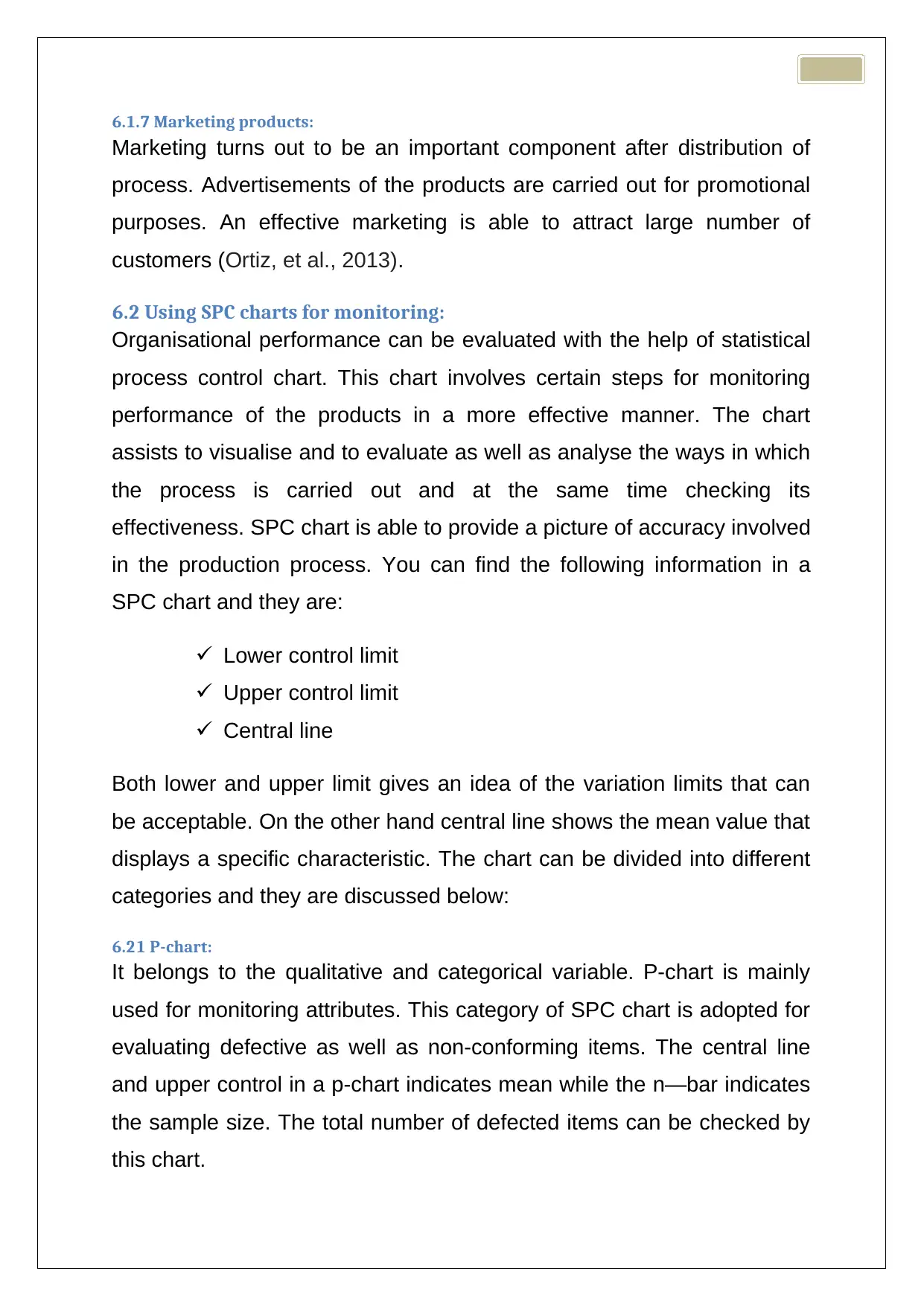
6.1.7 Marketing products:
Marketing turns out to be an important component after distribution of
process. Advertisements of the products are carried out for promotional
purposes. An effective marketing is able to attract large number of
customers (Ortiz, et al., 2013).
6.2 Using SPC charts for monitoring:
Organisational performance can be evaluated with the help of statistical
process control chart. This chart involves certain steps for monitoring
performance of the products in a more effective manner. The chart
assists to visualise and to evaluate as well as analyse the ways in which
the process is carried out and at the same time checking its
effectiveness. SPC chart is able to provide a picture of accuracy involved
in the production process. You can find the following information in a
SPC chart and they are:
Lower control limit
Upper control limit
Central line
Both lower and upper limit gives an idea of the variation limits that can
be acceptable. On the other hand central line shows the mean value that
displays a specific characteristic. The chart can be divided into different
categories and they are discussed below:
6.21 P-chart:
It belongs to the qualitative and categorical variable. P-chart is mainly
used for monitoring attributes. This category of SPC chart is adopted for
evaluating defective as well as non-conforming items. The central line
and upper control in a p-chart indicates mean while the n—bar indicates
the sample size. The total number of defected items can be checked by
this chart.
Marketing turns out to be an important component after distribution of
process. Advertisements of the products are carried out for promotional
purposes. An effective marketing is able to attract large number of
customers (Ortiz, et al., 2013).
6.2 Using SPC charts for monitoring:
Organisational performance can be evaluated with the help of statistical
process control chart. This chart involves certain steps for monitoring
performance of the products in a more effective manner. The chart
assists to visualise and to evaluate as well as analyse the ways in which
the process is carried out and at the same time checking its
effectiveness. SPC chart is able to provide a picture of accuracy involved
in the production process. You can find the following information in a
SPC chart and they are:
Lower control limit
Upper control limit
Central line
Both lower and upper limit gives an idea of the variation limits that can
be acceptable. On the other hand central line shows the mean value that
displays a specific characteristic. The chart can be divided into different
categories and they are discussed below:
6.21 P-chart:
It belongs to the qualitative and categorical variable. P-chart is mainly
used for monitoring attributes. This category of SPC chart is adopted for
evaluating defective as well as non-conforming items. The central line
and upper control in a p-chart indicates mean while the n—bar indicates
the sample size. The total number of defected items can be checked by
this chart.
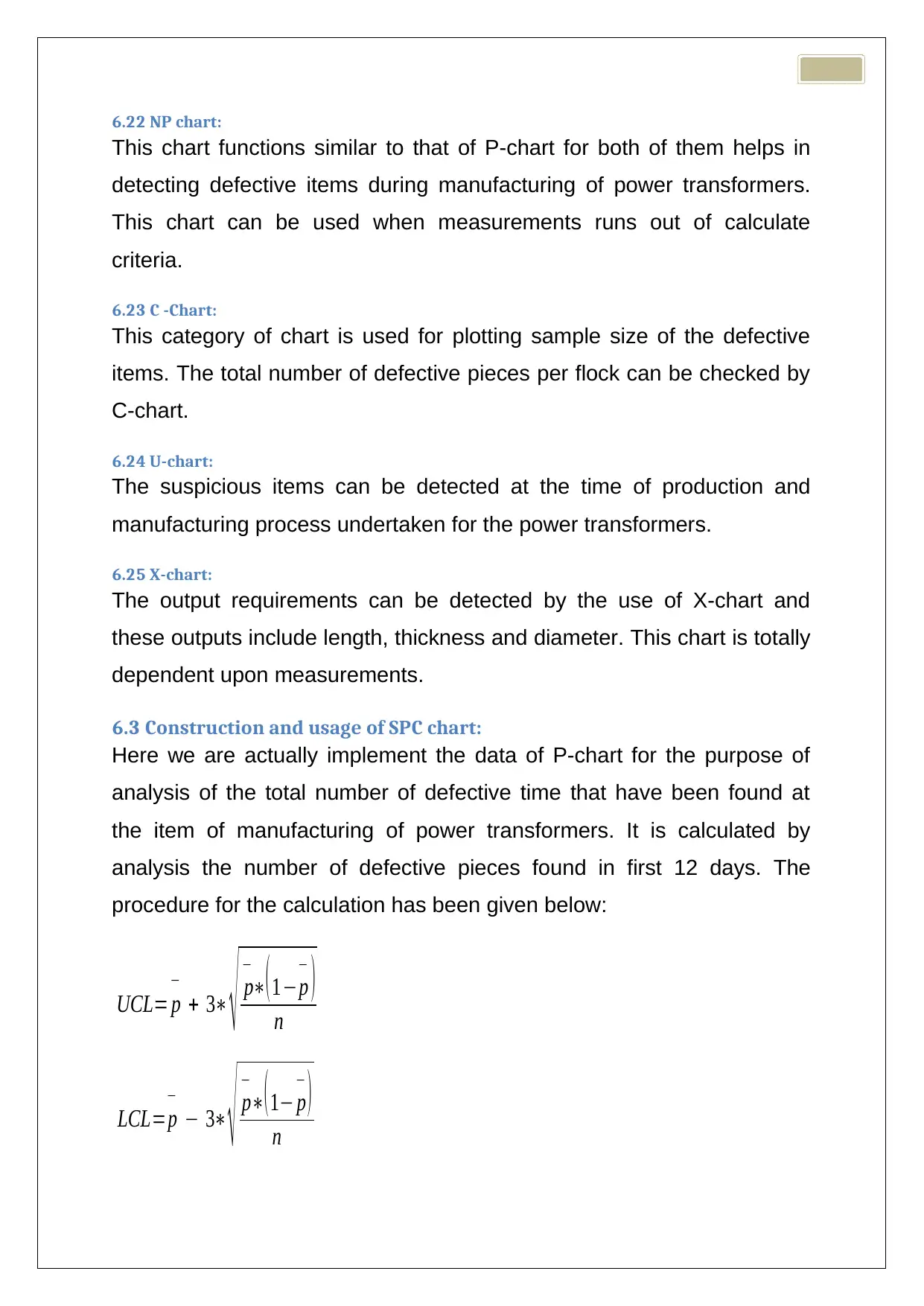
6.22 NP chart:
This chart functions similar to that of P-chart for both of them helps in
detecting defective items during manufacturing of power transformers.
This chart can be used when measurements runs out of calculate
criteria.
6.23 C -Chart:
This category of chart is used for plotting sample size of the defective
items. The total number of defective pieces per flock can be checked by
C-chart.
6.24 U-chart:
The suspicious items can be detected at the time of production and
manufacturing process undertaken for the power transformers.
6.25 X-chart:
The output requirements can be detected by the use of X-chart and
these outputs include length, thickness and diameter. This chart is totally
dependent upon measurements.
6.3 Construction and usage of SPC chart:
Here we are actually implement the data of P-chart for the purpose of
analysis of the total number of defective time that have been found at
the item of manufacturing of power transformers. It is calculated by
analysis the number of defective pieces found in first 12 days. The
procedure for the calculation has been given below:
UCL= p
−
+ 3∗ √ p
−
∗( 1−p
−
)
n
LCL=p
−
− 3∗ √ p
−
∗( 1− p
−
)
n
This chart functions similar to that of P-chart for both of them helps in
detecting defective items during manufacturing of power transformers.
This chart can be used when measurements runs out of calculate
criteria.
6.23 C -Chart:
This category of chart is used for plotting sample size of the defective
items. The total number of defective pieces per flock can be checked by
C-chart.
6.24 U-chart:
The suspicious items can be detected at the time of production and
manufacturing process undertaken for the power transformers.
6.25 X-chart:
The output requirements can be detected by the use of X-chart and
these outputs include length, thickness and diameter. This chart is totally
dependent upon measurements.
6.3 Construction and usage of SPC chart:
Here we are actually implement the data of P-chart for the purpose of
analysis of the total number of defective time that have been found at
the item of manufacturing of power transformers. It is calculated by
analysis the number of defective pieces found in first 12 days. The
procedure for the calculation has been given below:
UCL= p
−
+ 3∗ √ p
−
∗( 1−p
−
)
n
LCL=p
−
− 3∗ √ p
−
∗( 1− p
−
)
n
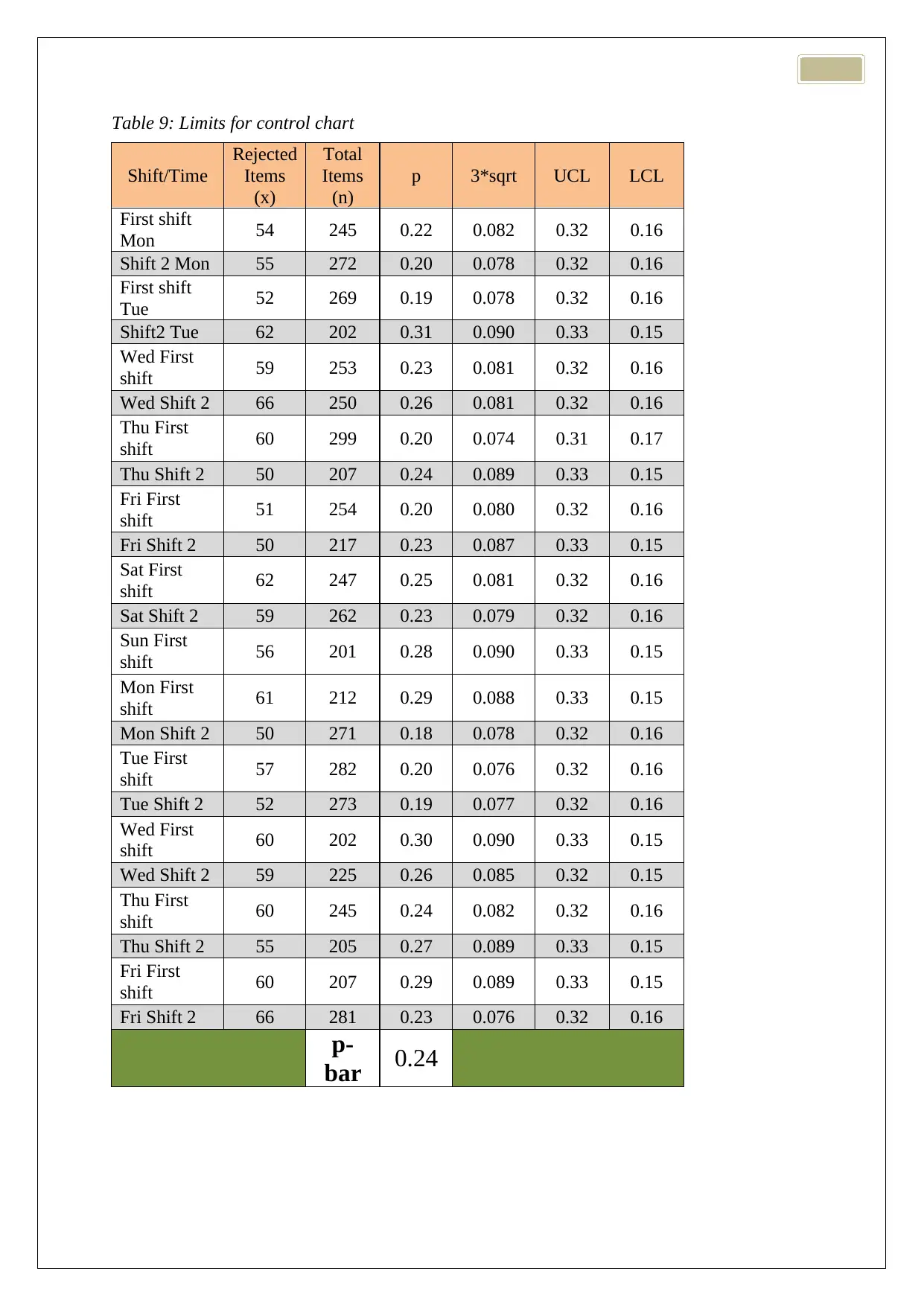
Table 9: Limits for control chart
Shift/Time
Rejected
Items
(x)
Total
Items
(n)
p 3*sqrt UCL LCL
First shift
Mon 54 245 0.22 0.082 0.32 0.16
Shift 2 Mon 55 272 0.20 0.078 0.32 0.16
First shift
Tue 52 269 0.19 0.078 0.32 0.16
Shift2 Tue 62 202 0.31 0.090 0.33 0.15
Wed First
shift 59 253 0.23 0.081 0.32 0.16
Wed Shift 2 66 250 0.26 0.081 0.32 0.16
Thu First
shift 60 299 0.20 0.074 0.31 0.17
Thu Shift 2 50 207 0.24 0.089 0.33 0.15
Fri First
shift 51 254 0.20 0.080 0.32 0.16
Fri Shift 2 50 217 0.23 0.087 0.33 0.15
Sat First
shift 62 247 0.25 0.081 0.32 0.16
Sat Shift 2 59 262 0.23 0.079 0.32 0.16
Sun First
shift 56 201 0.28 0.090 0.33 0.15
Mon First
shift 61 212 0.29 0.088 0.33 0.15
Mon Shift 2 50 271 0.18 0.078 0.32 0.16
Tue First
shift 57 282 0.20 0.076 0.32 0.16
Tue Shift 2 52 273 0.19 0.077 0.32 0.16
Wed First
shift 60 202 0.30 0.090 0.33 0.15
Wed Shift 2 59 225 0.26 0.085 0.32 0.15
Thu First
shift 60 245 0.24 0.082 0.32 0.16
Thu Shift 2 55 205 0.27 0.089 0.33 0.15
Fri First
shift 60 207 0.29 0.089 0.33 0.15
Fri Shift 2 66 281 0.23 0.076 0.32 0.16
p-
bar 0.24
Shift/Time
Rejected
Items
(x)
Total
Items
(n)
p 3*sqrt UCL LCL
First shift
Mon 54 245 0.22 0.082 0.32 0.16
Shift 2 Mon 55 272 0.20 0.078 0.32 0.16
First shift
Tue 52 269 0.19 0.078 0.32 0.16
Shift2 Tue 62 202 0.31 0.090 0.33 0.15
Wed First
shift 59 253 0.23 0.081 0.32 0.16
Wed Shift 2 66 250 0.26 0.081 0.32 0.16
Thu First
shift 60 299 0.20 0.074 0.31 0.17
Thu Shift 2 50 207 0.24 0.089 0.33 0.15
Fri First
shift 51 254 0.20 0.080 0.32 0.16
Fri Shift 2 50 217 0.23 0.087 0.33 0.15
Sat First
shift 62 247 0.25 0.081 0.32 0.16
Sat Shift 2 59 262 0.23 0.079 0.32 0.16
Sun First
shift 56 201 0.28 0.090 0.33 0.15
Mon First
shift 61 212 0.29 0.088 0.33 0.15
Mon Shift 2 50 271 0.18 0.078 0.32 0.16
Tue First
shift 57 282 0.20 0.076 0.32 0.16
Tue Shift 2 52 273 0.19 0.077 0.32 0.16
Wed First
shift 60 202 0.30 0.090 0.33 0.15
Wed Shift 2 59 225 0.26 0.085 0.32 0.15
Thu First
shift 60 245 0.24 0.082 0.32 0.16
Thu Shift 2 55 205 0.27 0.089 0.33 0.15
Fri First
shift 60 207 0.29 0.089 0.33 0.15
Fri Shift 2 66 281 0.23 0.076 0.32 0.16
p-
bar 0.24
Paraphrase This Document
Need a fresh take? Get an instant paraphrase of this document with our AI Paraphraser
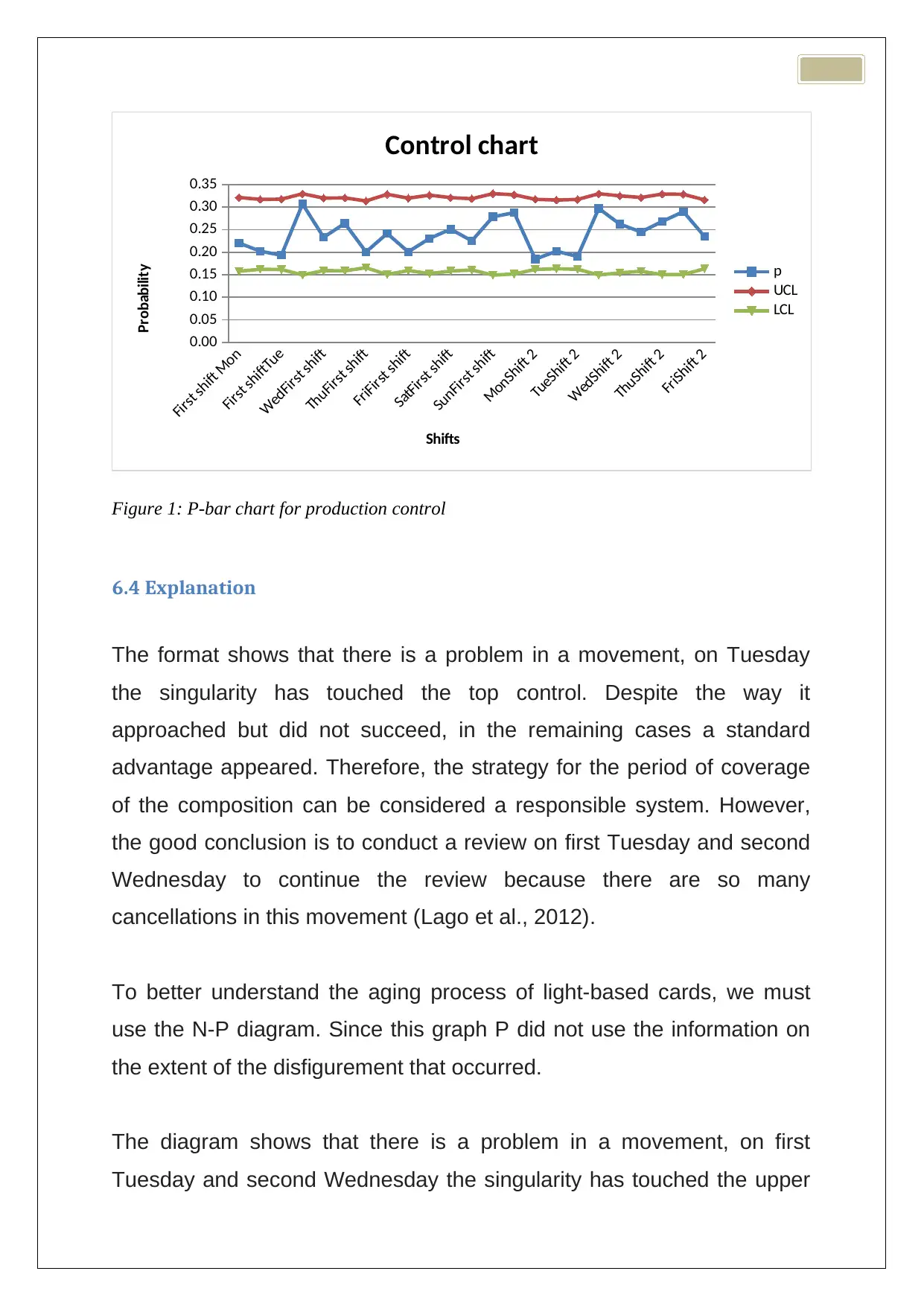
First shift Mon
First shiftTue
WedFirst shift
ThuFirst shift
FriFirst shift
SatFirst shift
SunFirst shift
MonShift 2
TueShift 2
WedShift 2
ThuShift 2
FriShift 2
0.00
0.05
0.10
0.15
0.20
0.25
0.30
0.35
Control chart
p
UCL
LCL
Shifts
Probability
Figure 1: P-bar chart for production control
6.4 Explanation
The format shows that there is a problem in a movement, on Tuesday
the singularity has touched the top control. Despite the way it
approached but did not succeed, in the remaining cases a standard
advantage appeared. Therefore, the strategy for the period of coverage
of the composition can be considered a responsible system. However,
the good conclusion is to conduct a review on first Tuesday and second
Wednesday to continue the review because there are so many
cancellations in this movement (Lago et al., 2012).
To better understand the aging process of light-based cards, we must
use the N-P diagram. Since this graph P did not use the information on
the extent of the disfigurement that occurred.
The diagram shows that there is a problem in a movement, on first
Tuesday and second Wednesday the singularity has touched the upper
First shiftTue
WedFirst shift
ThuFirst shift
FriFirst shift
SatFirst shift
SunFirst shift
MonShift 2
TueShift 2
WedShift 2
ThuShift 2
FriShift 2
0.00
0.05
0.10
0.15
0.20
0.25
0.30
0.35
Control chart
p
UCL
LCL
Shifts
Probability
Figure 1: P-bar chart for production control
6.4 Explanation
The format shows that there is a problem in a movement, on Tuesday
the singularity has touched the top control. Despite the way it
approached but did not succeed, in the remaining cases a standard
advantage appeared. Therefore, the strategy for the period of coverage
of the composition can be considered a responsible system. However,
the good conclusion is to conduct a review on first Tuesday and second
Wednesday to continue the review because there are so many
cancellations in this movement (Lago et al., 2012).
To better understand the aging process of light-based cards, we must
use the N-P diagram. Since this graph P did not use the information on
the extent of the disfigurement that occurred.
The diagram shows that there is a problem in a movement, on first
Tuesday and second Wednesday the singularity has touched the upper
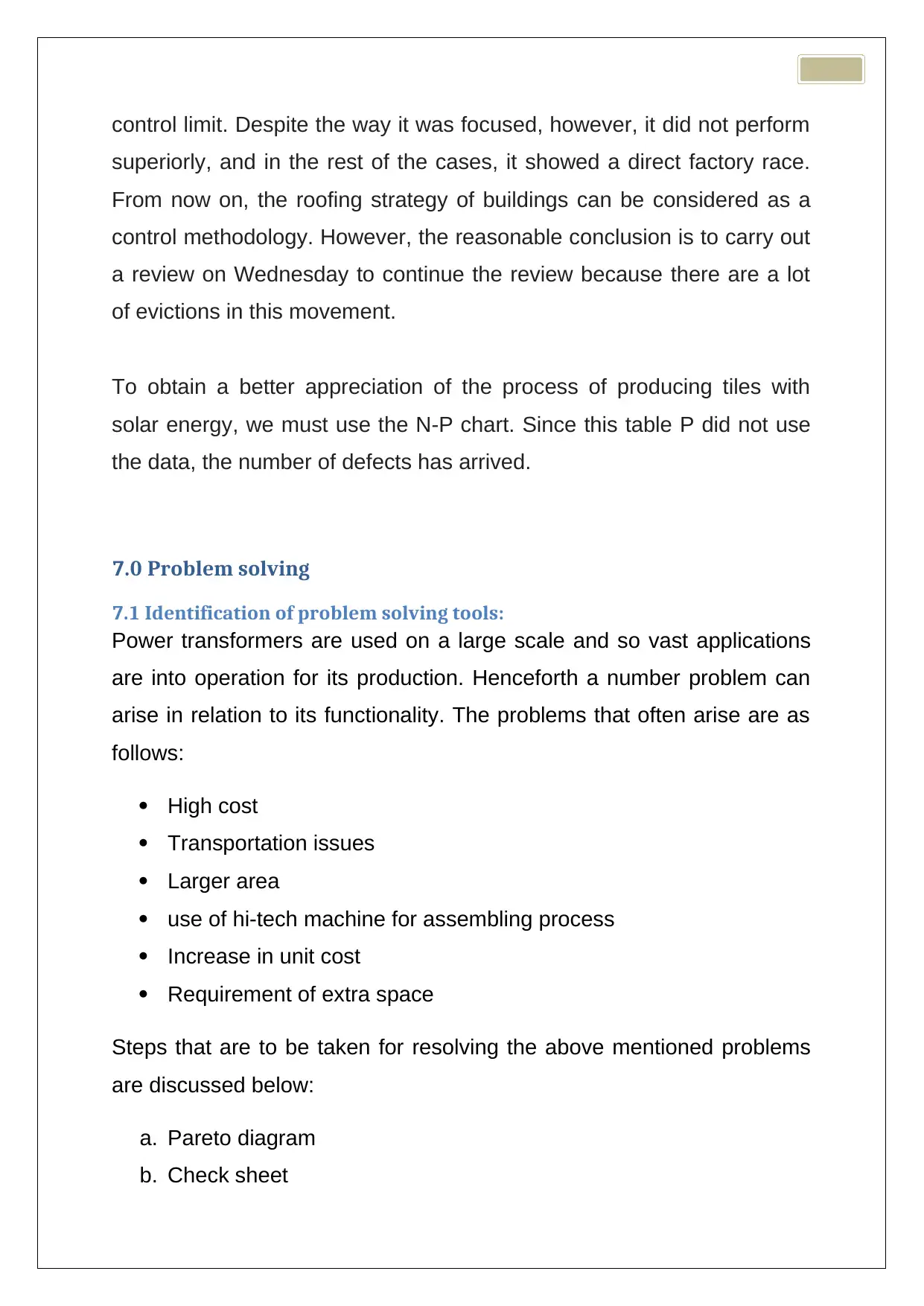
control limit. Despite the way it was focused, however, it did not perform
superiorly, and in the rest of the cases, it showed a direct factory race.
From now on, the roofing strategy of buildings can be considered as a
control methodology. However, the reasonable conclusion is to carry out
a review on Wednesday to continue the review because there are a lot
of evictions in this movement.
To obtain a better appreciation of the process of producing tiles with
solar energy, we must use the N-P chart. Since this table P did not use
the data, the number of defects has arrived.
7.0 Problem solving
7.1 Identification of problem solving tools:
Power transformers are used on a large scale and so vast applications
are into operation for its production. Henceforth a number problem can
arise in relation to its functionality. The problems that often arise are as
follows:
High cost
Transportation issues
Larger area
use of hi-tech machine for assembling process
Increase in unit cost
Requirement of extra space
Steps that are to be taken for resolving the above mentioned problems
are discussed below:
a. Pareto diagram
b. Check sheet
superiorly, and in the rest of the cases, it showed a direct factory race.
From now on, the roofing strategy of buildings can be considered as a
control methodology. However, the reasonable conclusion is to carry out
a review on Wednesday to continue the review because there are a lot
of evictions in this movement.
To obtain a better appreciation of the process of producing tiles with
solar energy, we must use the N-P chart. Since this table P did not use
the data, the number of defects has arrived.
7.0 Problem solving
7.1 Identification of problem solving tools:
Power transformers are used on a large scale and so vast applications
are into operation for its production. Henceforth a number problem can
arise in relation to its functionality. The problems that often arise are as
follows:
High cost
Transportation issues
Larger area
use of hi-tech machine for assembling process
Increase in unit cost
Requirement of extra space
Steps that are to be taken for resolving the above mentioned problems
are discussed below:
a. Pareto diagram
b. Check sheet
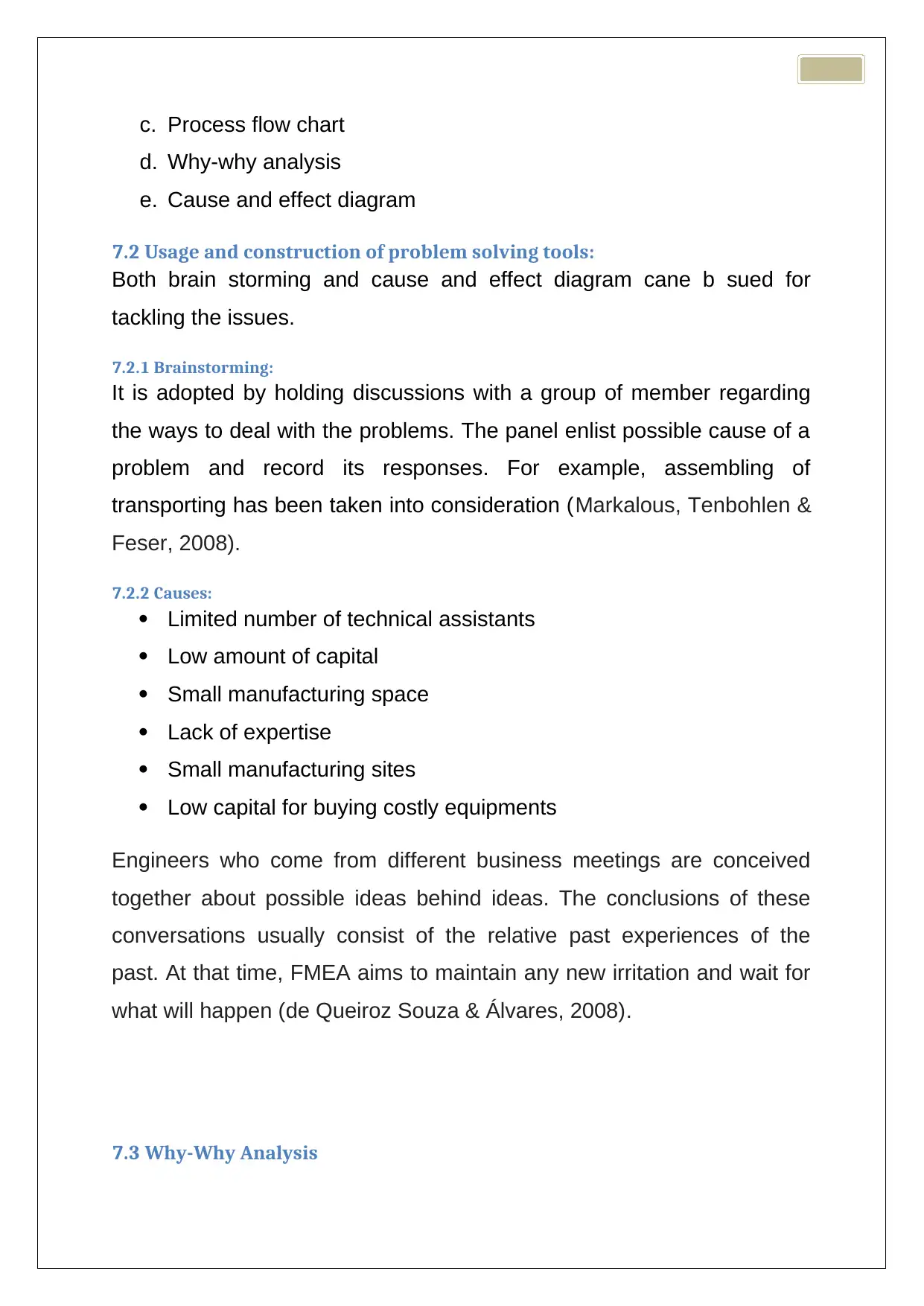
c. Process flow chart
d. Why-why analysis
e. Cause and effect diagram
7.2 Usage and construction of problem solving tools:
Both brain storming and cause and effect diagram cane b sued for
tackling the issues.
7.2.1 Brainstorming:
It is adopted by holding discussions with a group of member regarding
the ways to deal with the problems. The panel enlist possible cause of a
problem and record its responses. For example, assembling of
transporting has been taken into consideration (Markalous, Tenbohlen &
Feser, 2008).
7.2.2 Causes:
Limited number of technical assistants
Low amount of capital
Small manufacturing space
Lack of expertise
Small manufacturing sites
Low capital for buying costly equipments
Engineers who come from different business meetings are conceived
together about possible ideas behind ideas. The conclusions of these
conversations usually consist of the relative past experiences of the
past. At that time, FMEA aims to maintain any new irritation and wait for
what will happen (de Queiroz Souza & Álvares, 2008).
7.3 Why-Why Analysis
d. Why-why analysis
e. Cause and effect diagram
7.2 Usage and construction of problem solving tools:
Both brain storming and cause and effect diagram cane b sued for
tackling the issues.
7.2.1 Brainstorming:
It is adopted by holding discussions with a group of member regarding
the ways to deal with the problems. The panel enlist possible cause of a
problem and record its responses. For example, assembling of
transporting has been taken into consideration (Markalous, Tenbohlen &
Feser, 2008).
7.2.2 Causes:
Limited number of technical assistants
Low amount of capital
Small manufacturing space
Lack of expertise
Small manufacturing sites
Low capital for buying costly equipments
Engineers who come from different business meetings are conceived
together about possible ideas behind ideas. The conclusions of these
conversations usually consist of the relative past experiences of the
past. At that time, FMEA aims to maintain any new irritation and wait for
what will happen (de Queiroz Souza & Álvares, 2008).
7.3 Why-Why Analysis
Secure Best Marks with AI Grader
Need help grading? Try our AI Grader for instant feedback on your assignments.
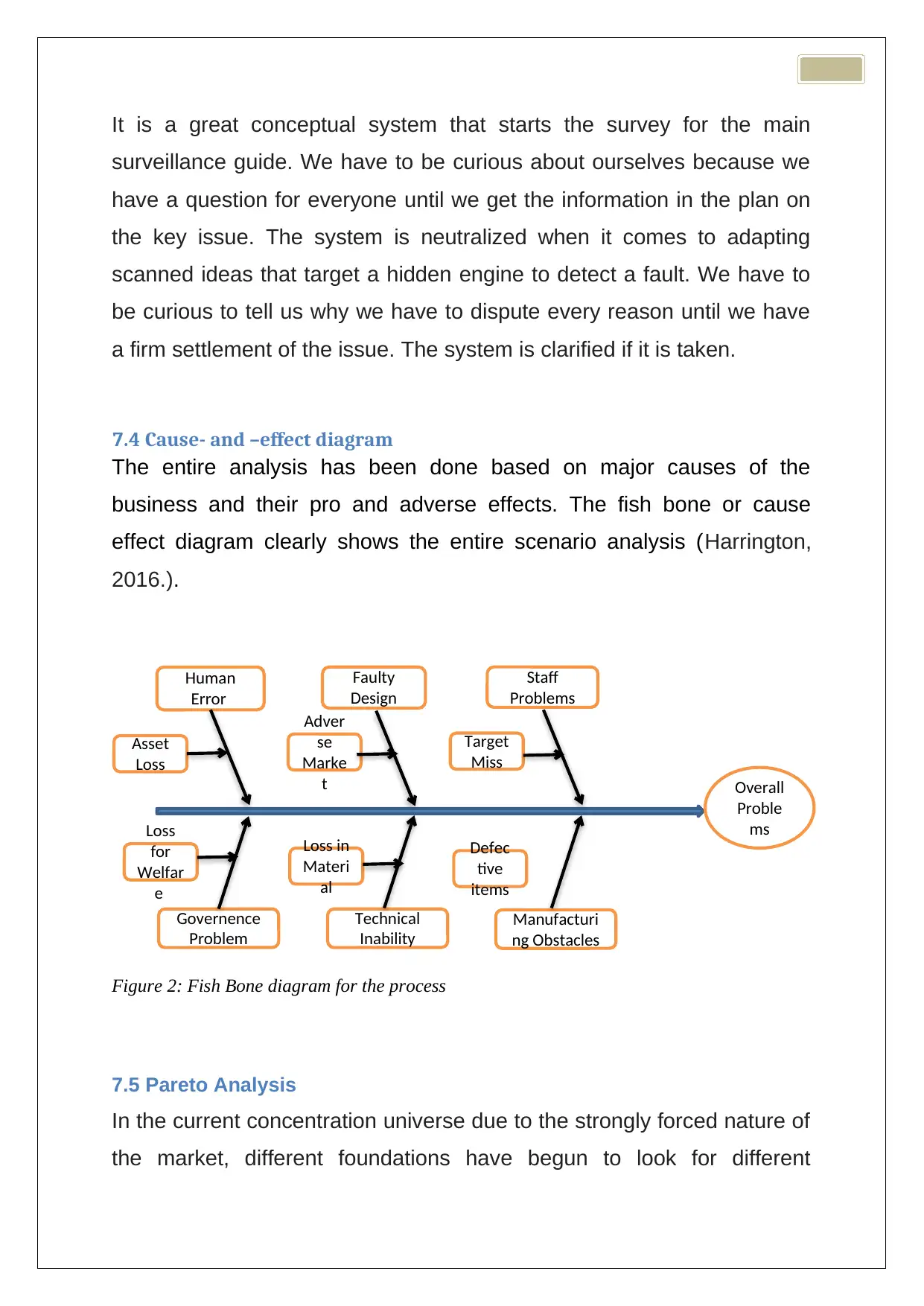
It is a great conceptual system that starts the survey for the main
surveillance guide. We have to be curious about ourselves because we
have a question for everyone until we get the information in the plan on
the key issue. The system is neutralized when it comes to adapting
scanned ideas that target a hidden engine to detect a fault. We have to
be curious to tell us why we have to dispute every reason until we have
a firm settlement of the issue. The system is clarified if it is taken.
7.4 Cause- and –effect diagram
The entire analysis has been done based on major causes of the
business and their pro and adverse effects. The fish bone or cause
effect diagram clearly shows the entire scenario analysis (Harrington,
2016.).
Figure 2: Fish Bone diagram for the process
7.5 Pareto Analysis
In the current concentration universe due to the strongly forced nature of
the market, different foundations have begun to look for different
Human
Error
Faulty
Design
Staff
Problems
Governence
Problem
Manufacturi
ng Obstacles
Technical
Inability
Asset
Loss
Defec
tive
items
Loss in
Materi
al
Loss
for
Welfar
e
Target
Miss
Adver
se
Marke
t Overall
Proble
ms
surveillance guide. We have to be curious about ourselves because we
have a question for everyone until we get the information in the plan on
the key issue. The system is neutralized when it comes to adapting
scanned ideas that target a hidden engine to detect a fault. We have to
be curious to tell us why we have to dispute every reason until we have
a firm settlement of the issue. The system is clarified if it is taken.
7.4 Cause- and –effect diagram
The entire analysis has been done based on major causes of the
business and their pro and adverse effects. The fish bone or cause
effect diagram clearly shows the entire scenario analysis (Harrington,
2016.).
Figure 2: Fish Bone diagram for the process
7.5 Pareto Analysis
In the current concentration universe due to the strongly forced nature of
the market, different foundations have begun to look for different
Human
Error
Faulty
Design
Staff
Problems
Governence
Problem
Manufacturi
ng Obstacles
Technical
Inability
Asset
Loss
Defec
tive
items
Loss in
Materi
al
Loss
for
Welfar
e
Target
Miss
Adver
se
Marke
t Overall
Proble
ms
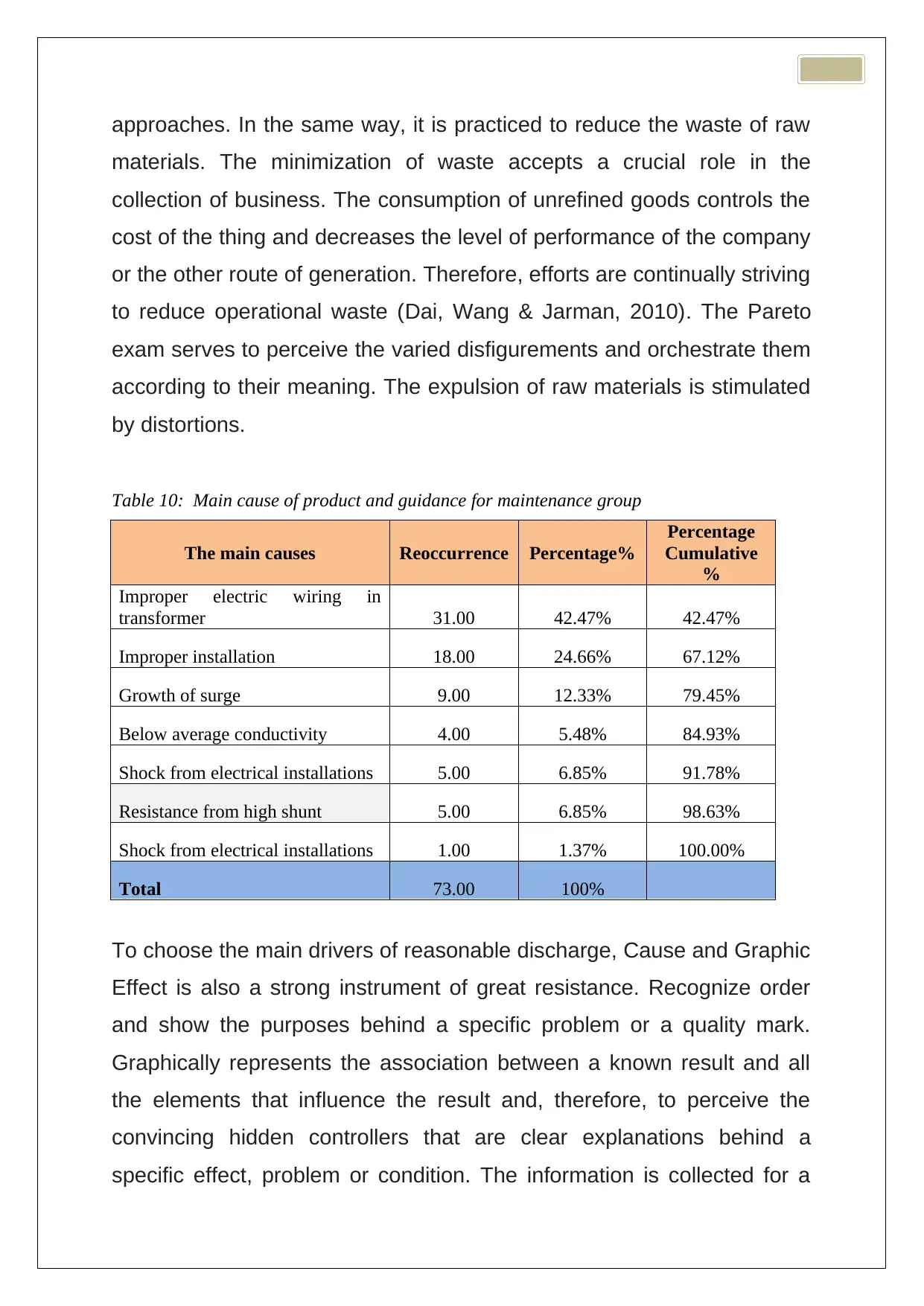
approaches. In the same way, it is practiced to reduce the waste of raw
materials. The minimization of waste accepts a crucial role in the
collection of business. The consumption of unrefined goods controls the
cost of the thing and decreases the level of performance of the company
or the other route of generation. Therefore, efforts are continually striving
to reduce operational waste (Dai, Wang & Jarman, 2010). The Pareto
exam serves to perceive the varied disfigurements and orchestrate them
according to their meaning. The expulsion of raw materials is stimulated
by distortions.
Table 10: Main cause of product and guidance for maintenance group
The main causes Reoccurrence Percentage%
Percentage
Cumulative
%
Improper electric wiring in
transformer 31.00 42.47% 42.47%
Improper installation 18.00 24.66% 67.12%
Growth of surge 9.00 12.33% 79.45%
Below average conductivity 4.00 5.48% 84.93%
Shock from electrical installations 5.00 6.85% 91.78%
Resistance from high shunt 5.00 6.85% 98.63%
Shock from electrical installations 1.00 1.37% 100.00%
Total 73.00 100%
To choose the main drivers of reasonable discharge, Cause and Graphic
Effect is also a strong instrument of great resistance. Recognize order
and show the purposes behind a specific problem or a quality mark.
Graphically represents the association between a known result and all
the elements that influence the result and, therefore, to perceive the
convincing hidden controllers that are clear explanations behind a
specific effect, problem or condition. The information is collected for a
materials. The minimization of waste accepts a crucial role in the
collection of business. The consumption of unrefined goods controls the
cost of the thing and decreases the level of performance of the company
or the other route of generation. Therefore, efforts are continually striving
to reduce operational waste (Dai, Wang & Jarman, 2010). The Pareto
exam serves to perceive the varied disfigurements and orchestrate them
according to their meaning. The expulsion of raw materials is stimulated
by distortions.
Table 10: Main cause of product and guidance for maintenance group
The main causes Reoccurrence Percentage%
Percentage
Cumulative
%
Improper electric wiring in
transformer 31.00 42.47% 42.47%
Improper installation 18.00 24.66% 67.12%
Growth of surge 9.00 12.33% 79.45%
Below average conductivity 4.00 5.48% 84.93%
Shock from electrical installations 5.00 6.85% 91.78%
Resistance from high shunt 5.00 6.85% 98.63%
Shock from electrical installations 1.00 1.37% 100.00%
Total 73.00 100%
To choose the main drivers of reasonable discharge, Cause and Graphic
Effect is also a strong instrument of great resistance. Recognize order
and show the purposes behind a specific problem or a quality mark.
Graphically represents the association between a known result and all
the elements that influence the result and, therefore, to perceive the
convincing hidden controllers that are clear explanations behind a
specific effect, problem or condition. The information is collected for a
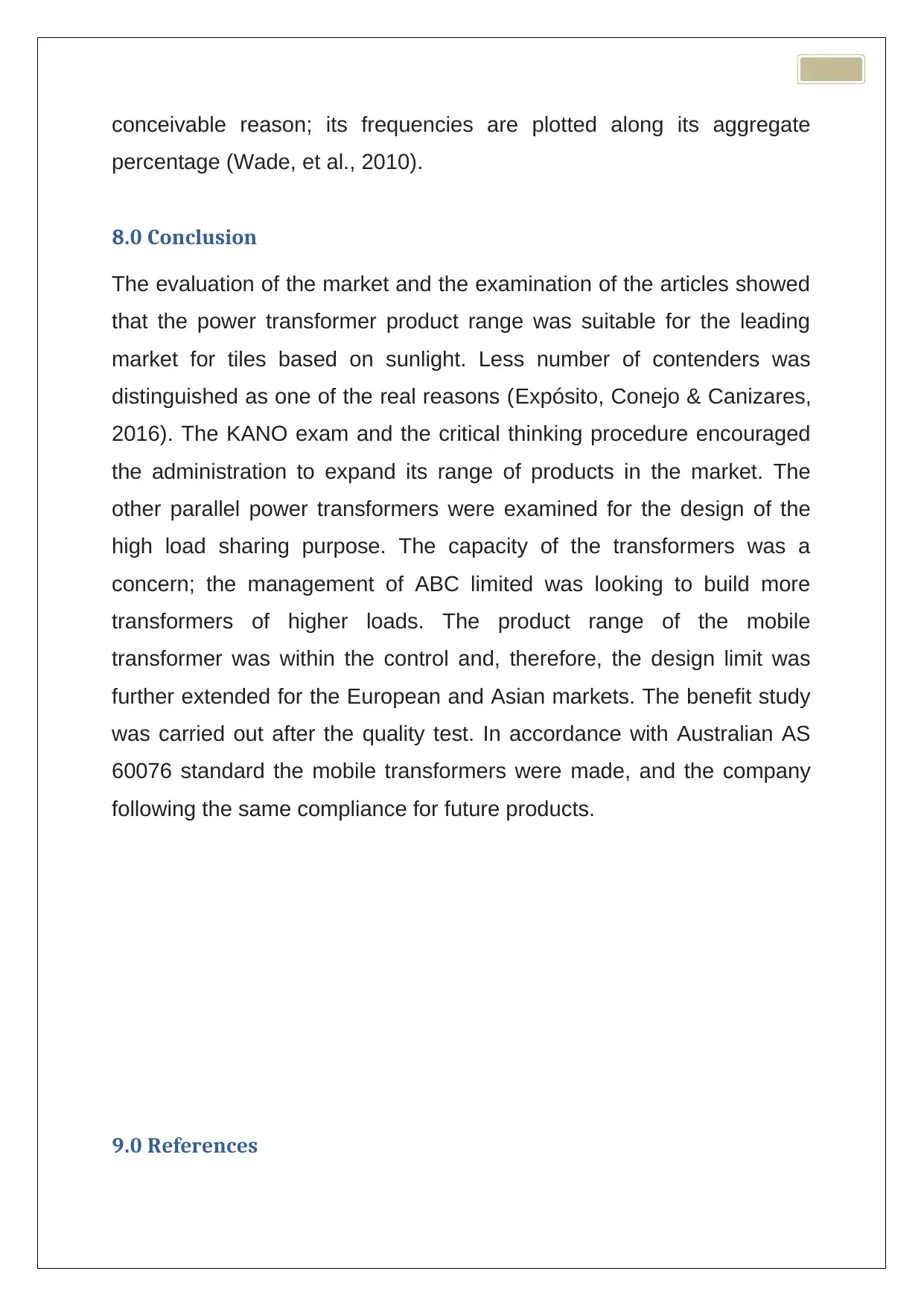
conceivable reason; its frequencies are plotted along its aggregate
percentage (Wade, et al., 2010).
8.0 Conclusion
The evaluation of the market and the examination of the articles showed
that the power transformer product range was suitable for the leading
market for tiles based on sunlight. Less number of contenders was
distinguished as one of the real reasons (Expósito, Conejo & Canizares,
2016). The KANO exam and the critical thinking procedure encouraged
the administration to expand its range of products in the market. The
other parallel power transformers were examined for the design of the
high load sharing purpose. The capacity of the transformers was a
concern; the management of ABC limited was looking to build more
transformers of higher loads. The product range of the mobile
transformer was within the control and, therefore, the design limit was
further extended for the European and Asian markets. The benefit study
was carried out after the quality test. In accordance with Australian AS
60076 standard the mobile transformers were made, and the company
following the same compliance for future products.
9.0 References
percentage (Wade, et al., 2010).
8.0 Conclusion
The evaluation of the market and the examination of the articles showed
that the power transformer product range was suitable for the leading
market for tiles based on sunlight. Less number of contenders was
distinguished as one of the real reasons (Expósito, Conejo & Canizares,
2016). The KANO exam and the critical thinking procedure encouraged
the administration to expand its range of products in the market. The
other parallel power transformers were examined for the design of the
high load sharing purpose. The capacity of the transformers was a
concern; the management of ABC limited was looking to build more
transformers of higher loads. The product range of the mobile
transformer was within the control and, therefore, the design limit was
further extended for the European and Asian markets. The benefit study
was carried out after the quality test. In accordance with Australian AS
60076 standard the mobile transformers were made, and the company
following the same compliance for future products.
9.0 References
Paraphrase This Document
Need a fresh take? Get an instant paraphrase of this document with our AI Paraphraser
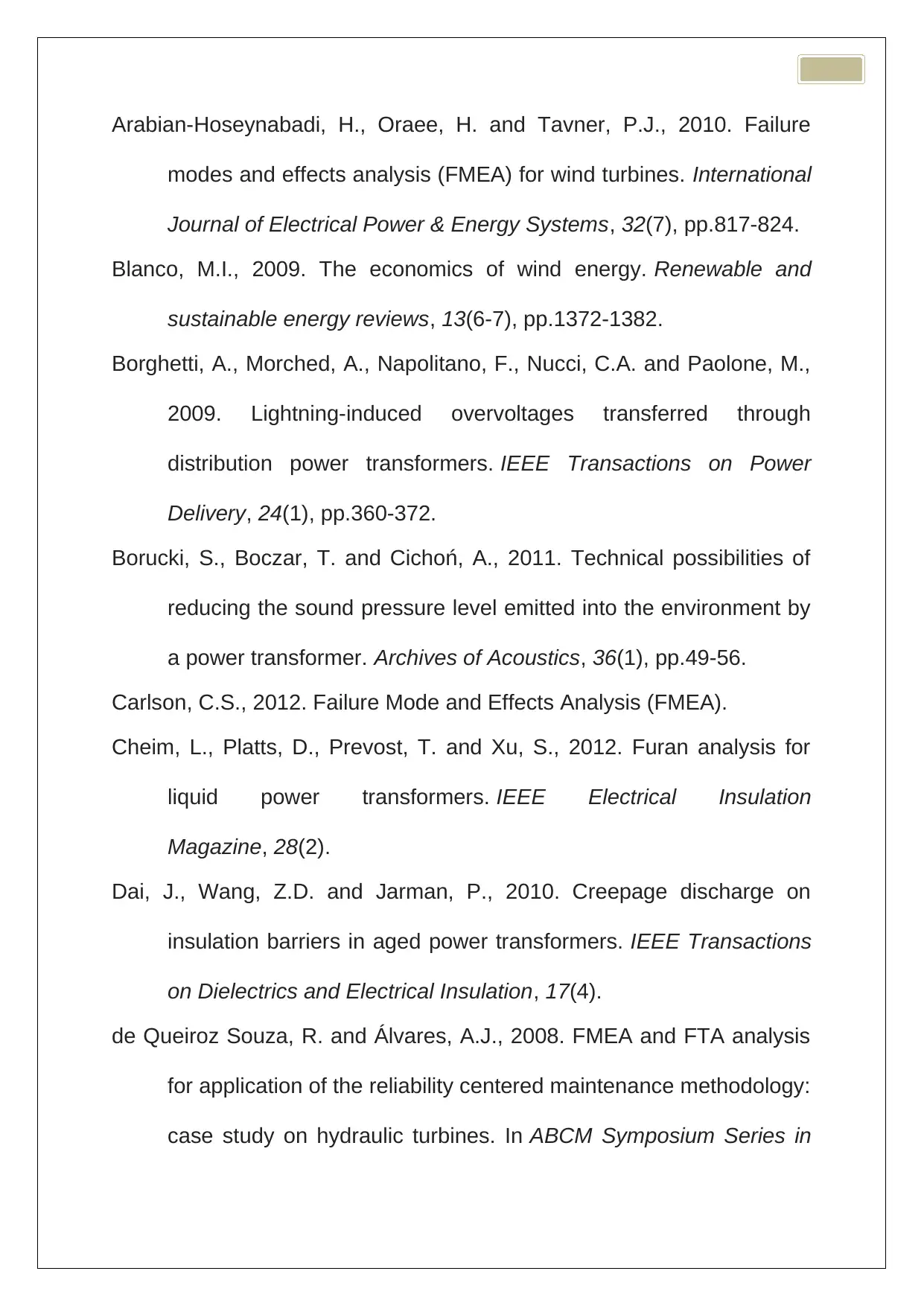
Arabian-Hoseynabadi, H., Oraee, H. and Tavner, P.J., 2010. Failure
modes and effects analysis (FMEA) for wind turbines. International
Journal of Electrical Power & Energy Systems, 32(7), pp.817-824.
Blanco, M.I., 2009. The economics of wind energy. Renewable and
sustainable energy reviews, 13(6-7), pp.1372-1382.
Borghetti, A., Morched, A., Napolitano, F., Nucci, C.A. and Paolone, M.,
2009. Lightning-induced overvoltages transferred through
distribution power transformers. IEEE Transactions on Power
Delivery, 24(1), pp.360-372.
Borucki, S., Boczar, T. and Cichoń, A., 2011. Technical possibilities of
reducing the sound pressure level emitted into the environment by
a power transformer. Archives of Acoustics, 36(1), pp.49-56.
Carlson, C.S., 2012. Failure Mode and Effects Analysis (FMEA).
Cheim, L., Platts, D., Prevost, T. and Xu, S., 2012. Furan analysis for
liquid power transformers. IEEE Electrical Insulation
Magazine, 28(2).
Dai, J., Wang, Z.D. and Jarman, P., 2010. Creepage discharge on
insulation barriers in aged power transformers. IEEE Transactions
on Dielectrics and Electrical Insulation, 17(4).
de Queiroz Souza, R. and Álvares, A.J., 2008. FMEA and FTA analysis
for application of the reliability centered maintenance methodology:
case study on hydraulic turbines. In ABCM Symposium Series in
modes and effects analysis (FMEA) for wind turbines. International
Journal of Electrical Power & Energy Systems, 32(7), pp.817-824.
Blanco, M.I., 2009. The economics of wind energy. Renewable and
sustainable energy reviews, 13(6-7), pp.1372-1382.
Borghetti, A., Morched, A., Napolitano, F., Nucci, C.A. and Paolone, M.,
2009. Lightning-induced overvoltages transferred through
distribution power transformers. IEEE Transactions on Power
Delivery, 24(1), pp.360-372.
Borucki, S., Boczar, T. and Cichoń, A., 2011. Technical possibilities of
reducing the sound pressure level emitted into the environment by
a power transformer. Archives of Acoustics, 36(1), pp.49-56.
Carlson, C.S., 2012. Failure Mode and Effects Analysis (FMEA).
Cheim, L., Platts, D., Prevost, T. and Xu, S., 2012. Furan analysis for
liquid power transformers. IEEE Electrical Insulation
Magazine, 28(2).
Dai, J., Wang, Z.D. and Jarman, P., 2010. Creepage discharge on
insulation barriers in aged power transformers. IEEE Transactions
on Dielectrics and Electrical Insulation, 17(4).
de Queiroz Souza, R. and Álvares, A.J., 2008. FMEA and FTA analysis
for application of the reliability centered maintenance methodology:
case study on hydraulic turbines. In ABCM Symposium Series in
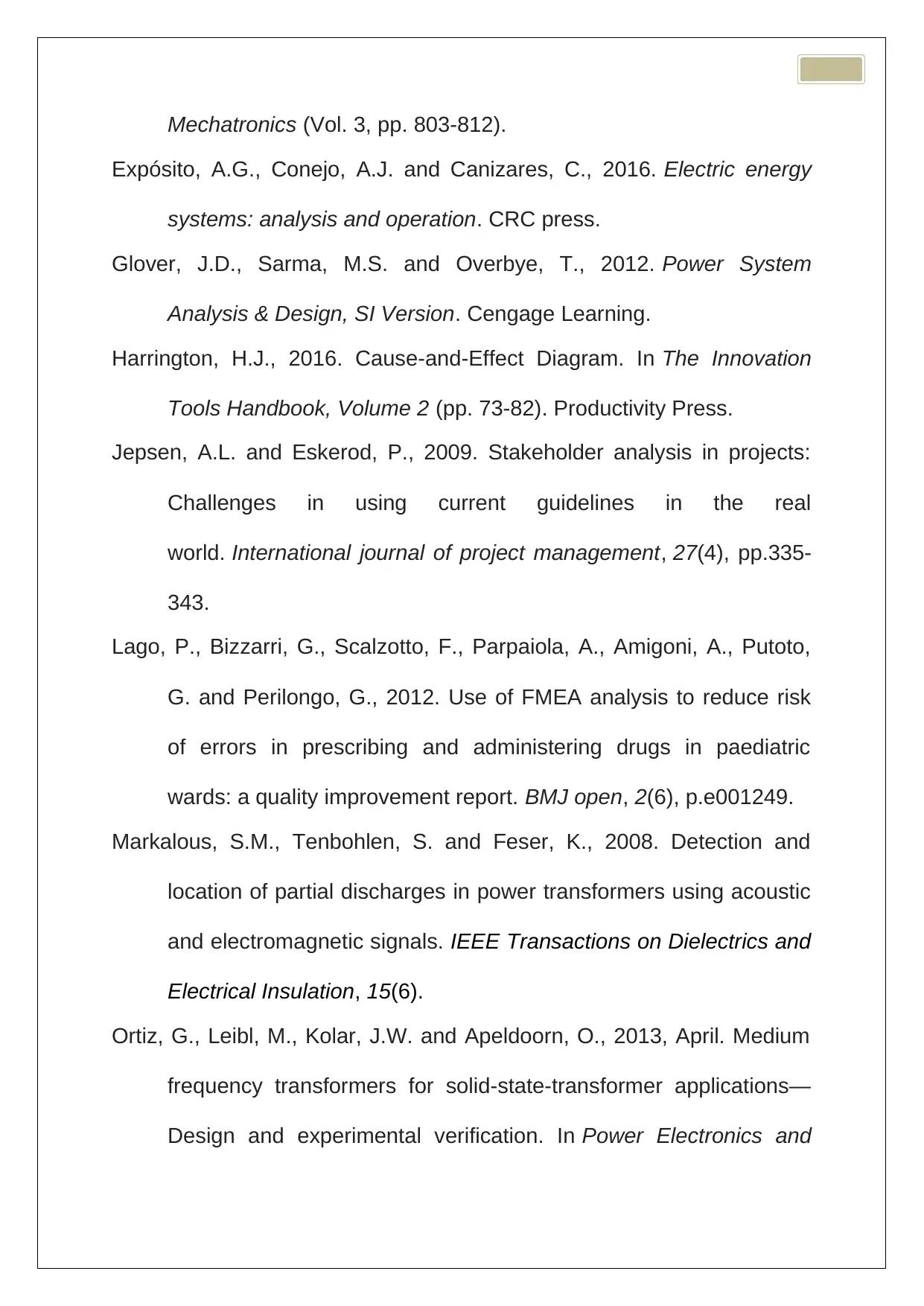
Mechatronics (Vol. 3, pp. 803-812).
Expósito, A.G., Conejo, A.J. and Canizares, C., 2016. Electric energy
systems: analysis and operation. CRC press.
Glover, J.D., Sarma, M.S. and Overbye, T., 2012. Power System
Analysis & Design, SI Version. Cengage Learning.
Harrington, H.J., 2016. Cause-and-Effect Diagram. In The Innovation
Tools Handbook, Volume 2 (pp. 73-82). Productivity Press.
Jepsen, A.L. and Eskerod, P., 2009. Stakeholder analysis in projects:
Challenges in using current guidelines in the real
world. International journal of project management, 27(4), pp.335-
343.
Lago, P., Bizzarri, G., Scalzotto, F., Parpaiola, A., Amigoni, A., Putoto,
G. and Perilongo, G., 2012. Use of FMEA analysis to reduce risk
of errors in prescribing and administering drugs in paediatric
wards: a quality improvement report. BMJ open, 2(6), p.e001249.
Markalous, S.M., Tenbohlen, S. and Feser, K., 2008. Detection and
location of partial discharges in power transformers using acoustic
and electromagnetic signals. IEEE Transactions on Dielectrics and
Electrical Insulation, 15(6).
Ortiz, G., Leibl, M., Kolar, J.W. and Apeldoorn, O., 2013, April. Medium
frequency transformers for solid-state-transformer applications—
Design and experimental verification. In Power Electronics and
Expósito, A.G., Conejo, A.J. and Canizares, C., 2016. Electric energy
systems: analysis and operation. CRC press.
Glover, J.D., Sarma, M.S. and Overbye, T., 2012. Power System
Analysis & Design, SI Version. Cengage Learning.
Harrington, H.J., 2016. Cause-and-Effect Diagram. In The Innovation
Tools Handbook, Volume 2 (pp. 73-82). Productivity Press.
Jepsen, A.L. and Eskerod, P., 2009. Stakeholder analysis in projects:
Challenges in using current guidelines in the real
world. International journal of project management, 27(4), pp.335-
343.
Lago, P., Bizzarri, G., Scalzotto, F., Parpaiola, A., Amigoni, A., Putoto,
G. and Perilongo, G., 2012. Use of FMEA analysis to reduce risk
of errors in prescribing and administering drugs in paediatric
wards: a quality improvement report. BMJ open, 2(6), p.e001249.
Markalous, S.M., Tenbohlen, S. and Feser, K., 2008. Detection and
location of partial discharges in power transformers using acoustic
and electromagnetic signals. IEEE Transactions on Dielectrics and
Electrical Insulation, 15(6).
Ortiz, G., Leibl, M., Kolar, J.W. and Apeldoorn, O., 2013, April. Medium
frequency transformers for solid-state-transformer applications—
Design and experimental verification. In Power Electronics and
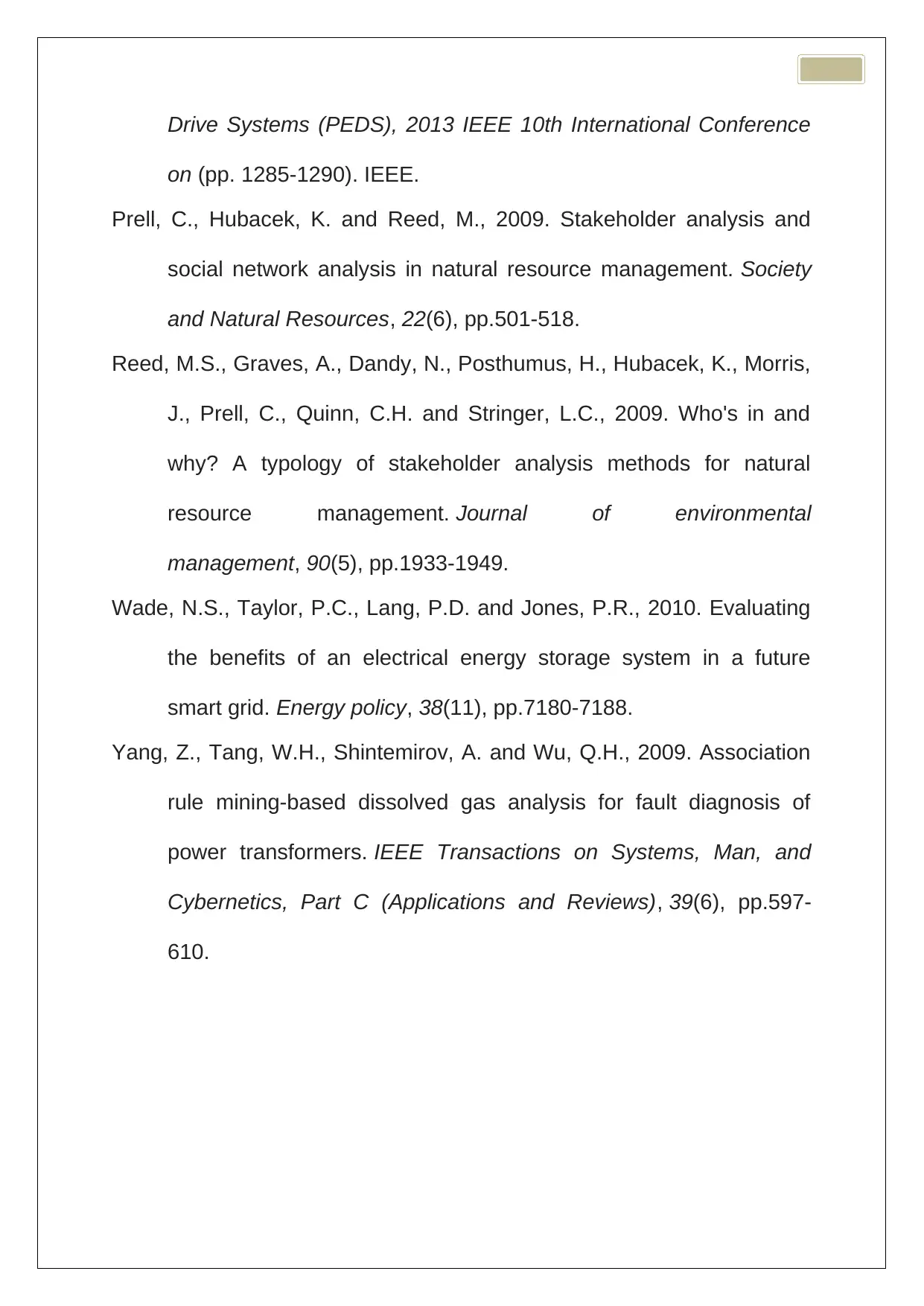
Drive Systems (PEDS), 2013 IEEE 10th International Conference
on (pp. 1285-1290). IEEE.
Prell, C., Hubacek, K. and Reed, M., 2009. Stakeholder analysis and
social network analysis in natural resource management. Society
and Natural Resources, 22(6), pp.501-518.
Reed, M.S., Graves, A., Dandy, N., Posthumus, H., Hubacek, K., Morris,
J., Prell, C., Quinn, C.H. and Stringer, L.C., 2009. Who's in and
why? A typology of stakeholder analysis methods for natural
resource management. Journal of environmental
management, 90(5), pp.1933-1949.
Wade, N.S., Taylor, P.C., Lang, P.D. and Jones, P.R., 2010. Evaluating
the benefits of an electrical energy storage system in a future
smart grid. Energy policy, 38(11), pp.7180-7188.
Yang, Z., Tang, W.H., Shintemirov, A. and Wu, Q.H., 2009. Association
rule mining-based dissolved gas analysis for fault diagnosis of
power transformers. IEEE Transactions on Systems, Man, and
Cybernetics, Part C (Applications and Reviews), 39(6), pp.597-
610.
on (pp. 1285-1290). IEEE.
Prell, C., Hubacek, K. and Reed, M., 2009. Stakeholder analysis and
social network analysis in natural resource management. Society
and Natural Resources, 22(6), pp.501-518.
Reed, M.S., Graves, A., Dandy, N., Posthumus, H., Hubacek, K., Morris,
J., Prell, C., Quinn, C.H. and Stringer, L.C., 2009. Who's in and
why? A typology of stakeholder analysis methods for natural
resource management. Journal of environmental
management, 90(5), pp.1933-1949.
Wade, N.S., Taylor, P.C., Lang, P.D. and Jones, P.R., 2010. Evaluating
the benefits of an electrical energy storage system in a future
smart grid. Energy policy, 38(11), pp.7180-7188.
Yang, Z., Tang, W.H., Shintemirov, A. and Wu, Q.H., 2009. Association
rule mining-based dissolved gas analysis for fault diagnosis of
power transformers. IEEE Transactions on Systems, Man, and
Cybernetics, Part C (Applications and Reviews), 39(6), pp.597-
610.
1 out of 34
Related Documents
Your All-in-One AI-Powered Toolkit for Academic Success.
+13062052269
info@desklib.com
Available 24*7 on WhatsApp / Email
![[object Object]](/_next/static/media/star-bottom.7253800d.svg)
Unlock your academic potential
© 2024 | Zucol Services PVT LTD | All rights reserved.





